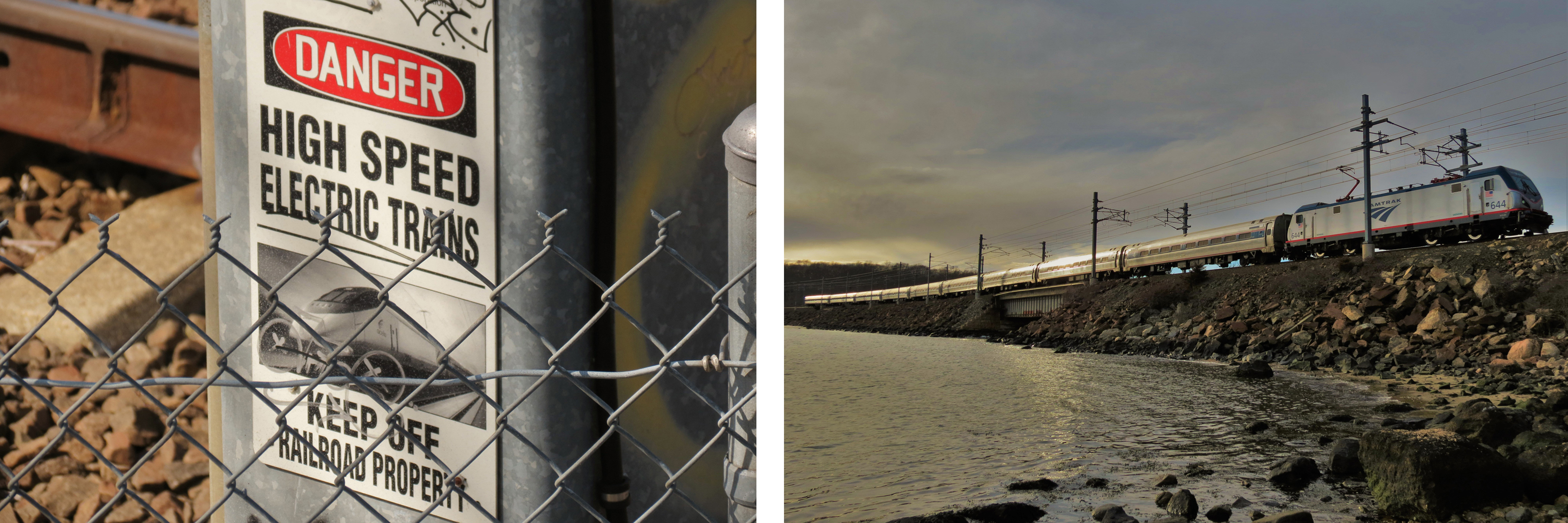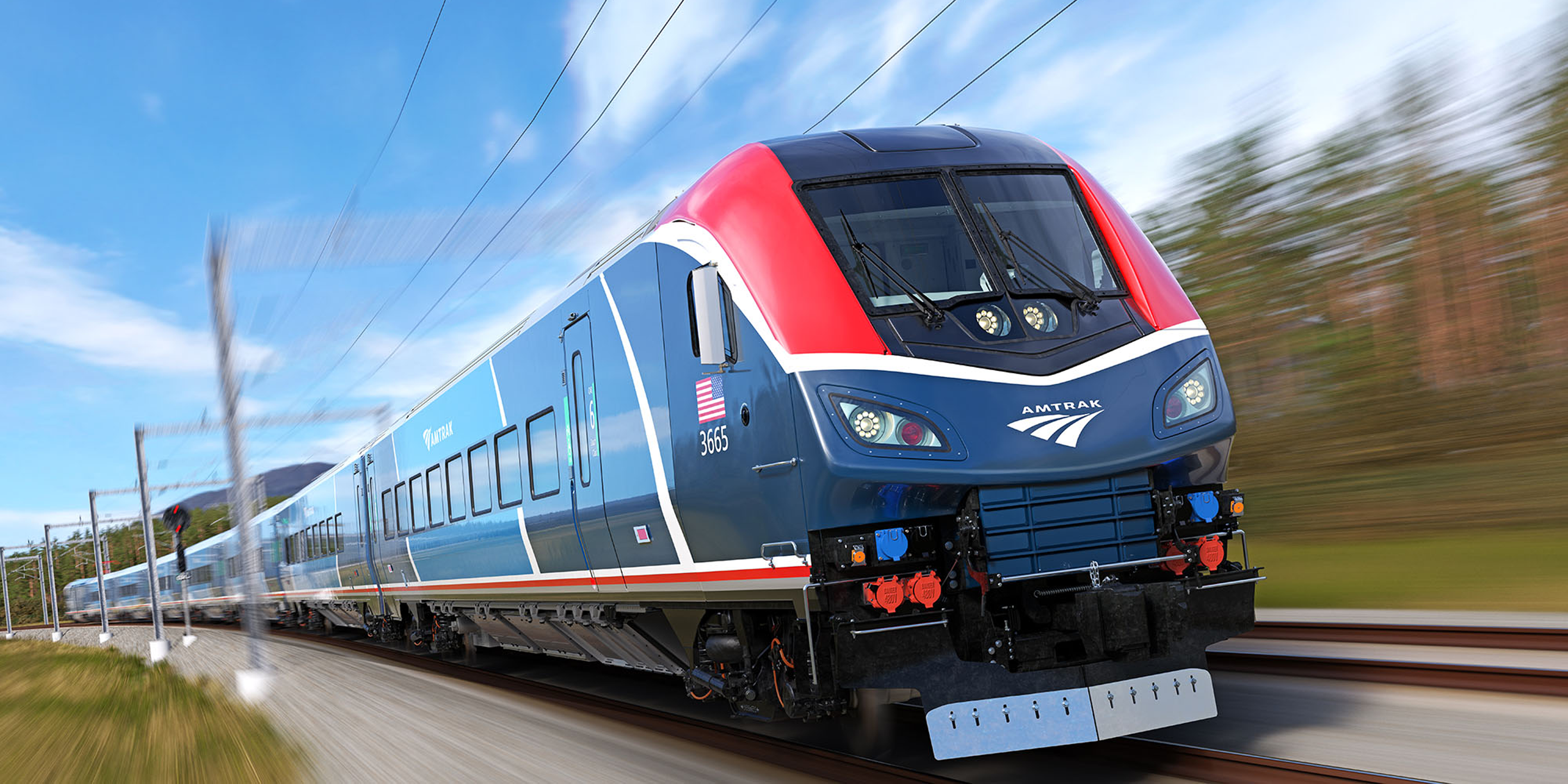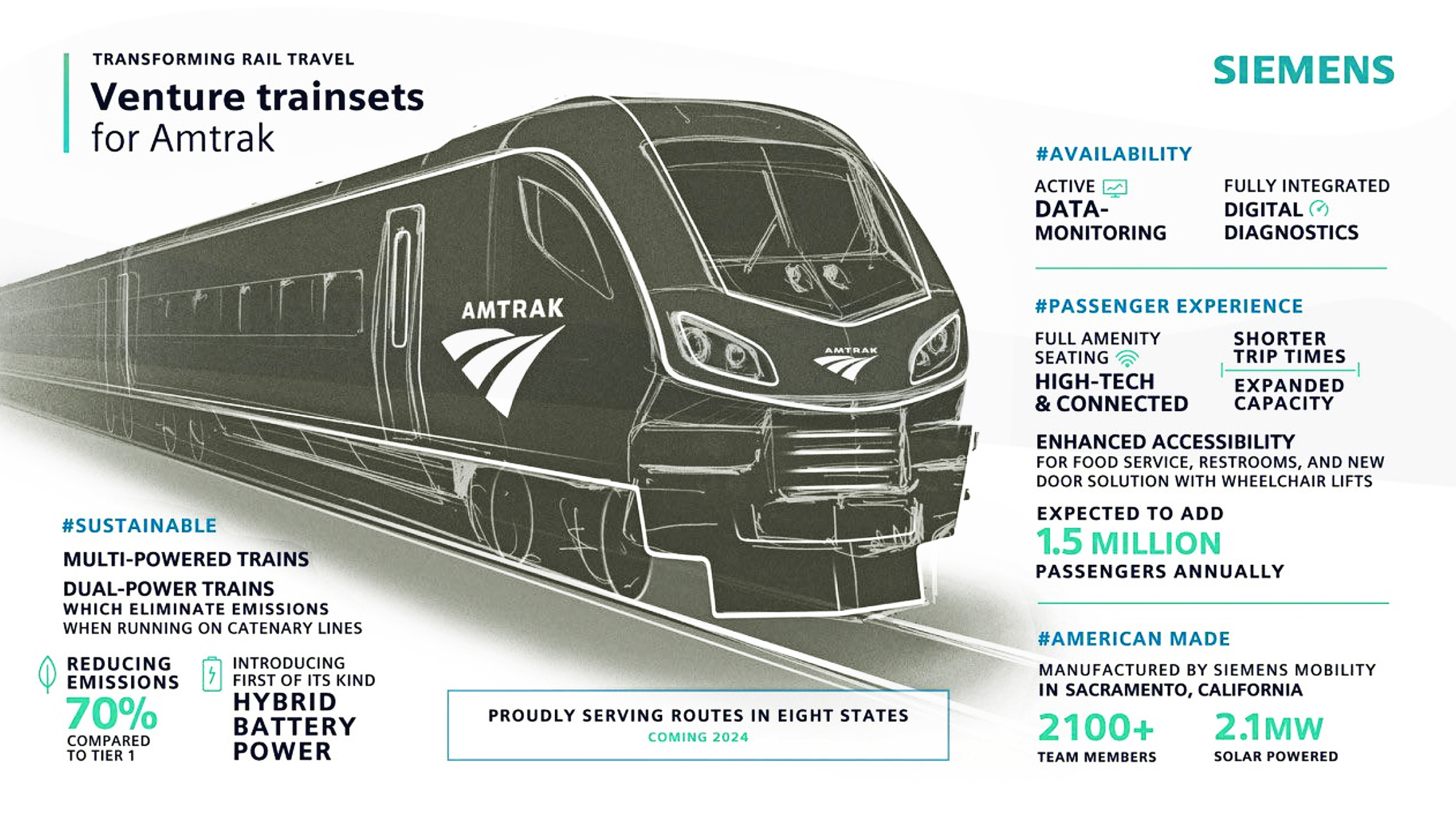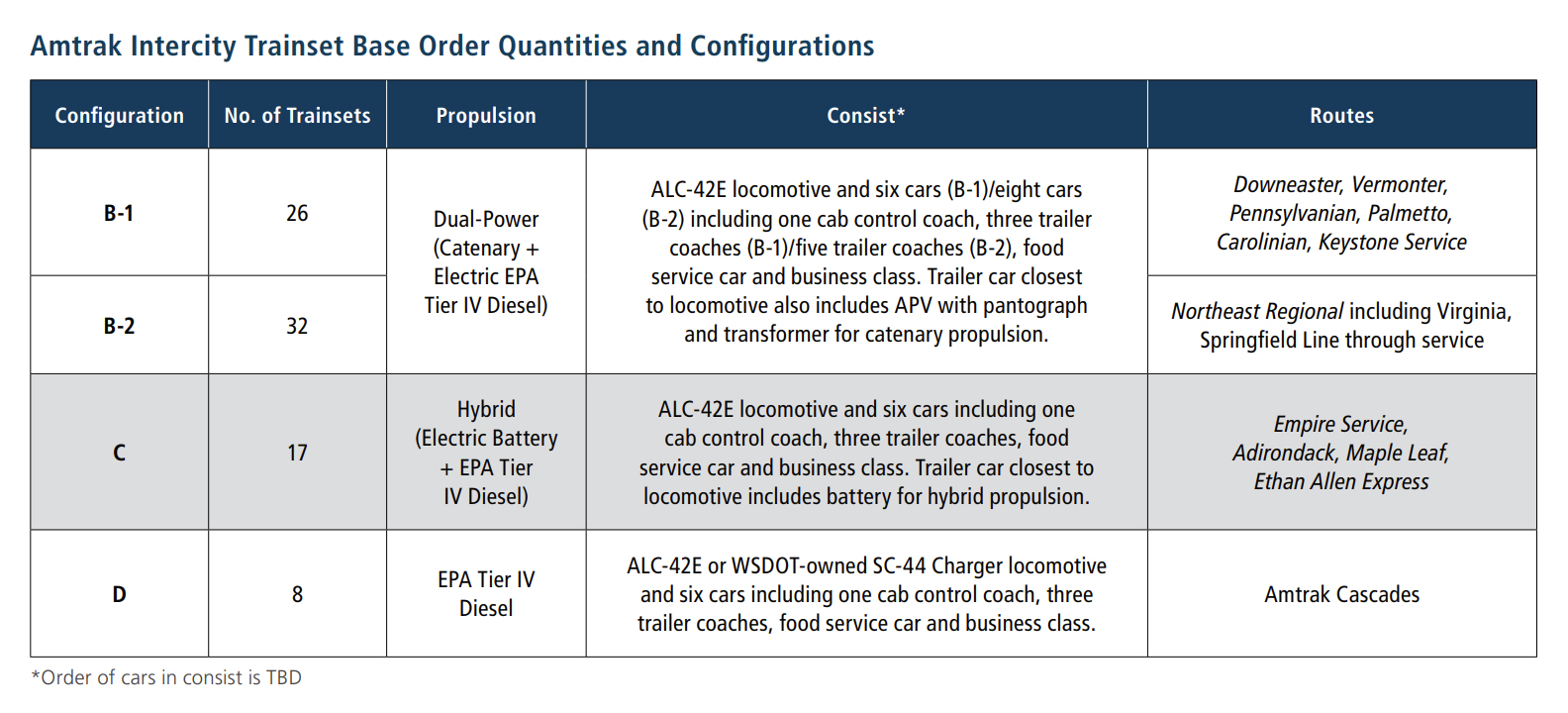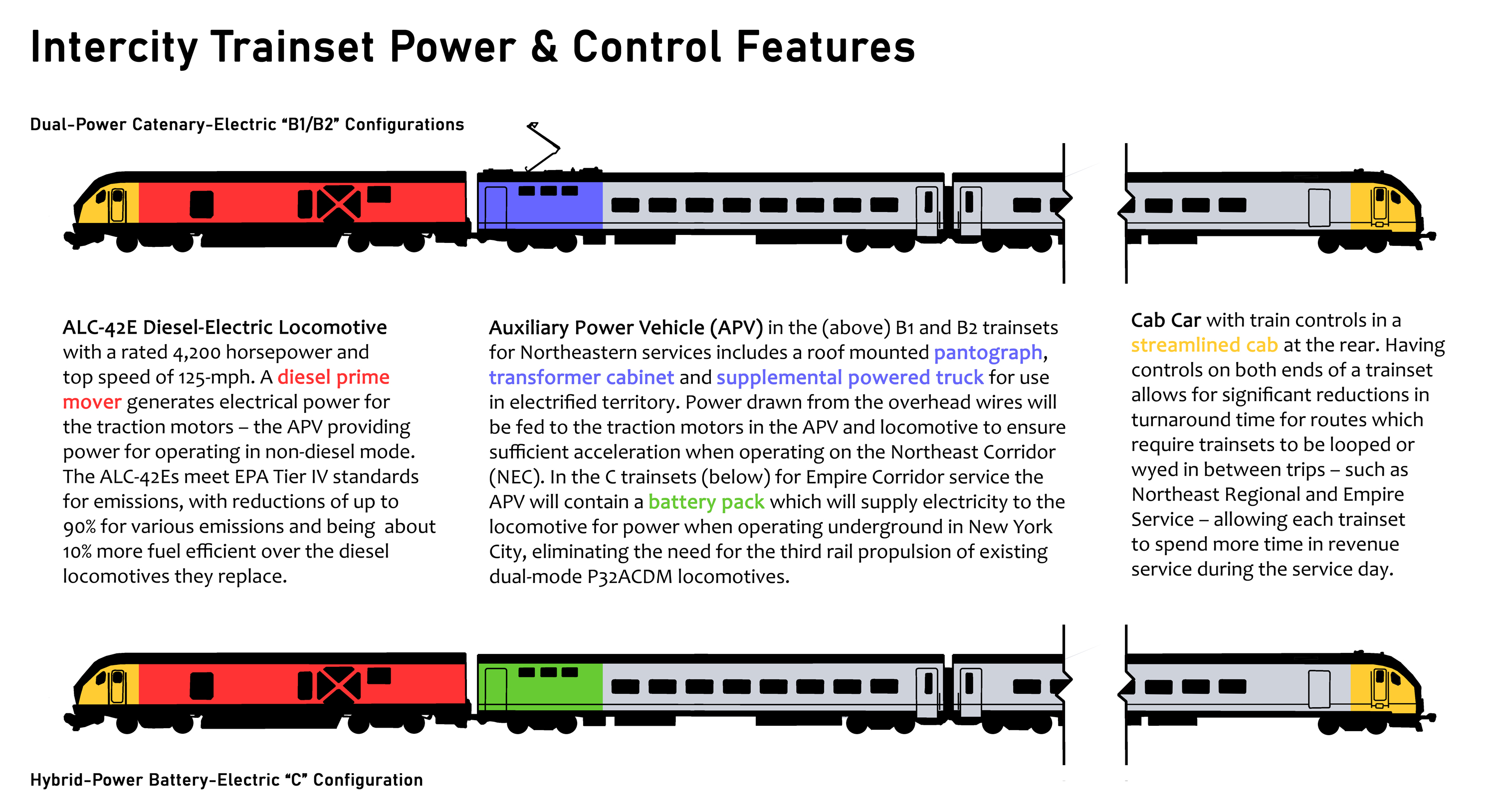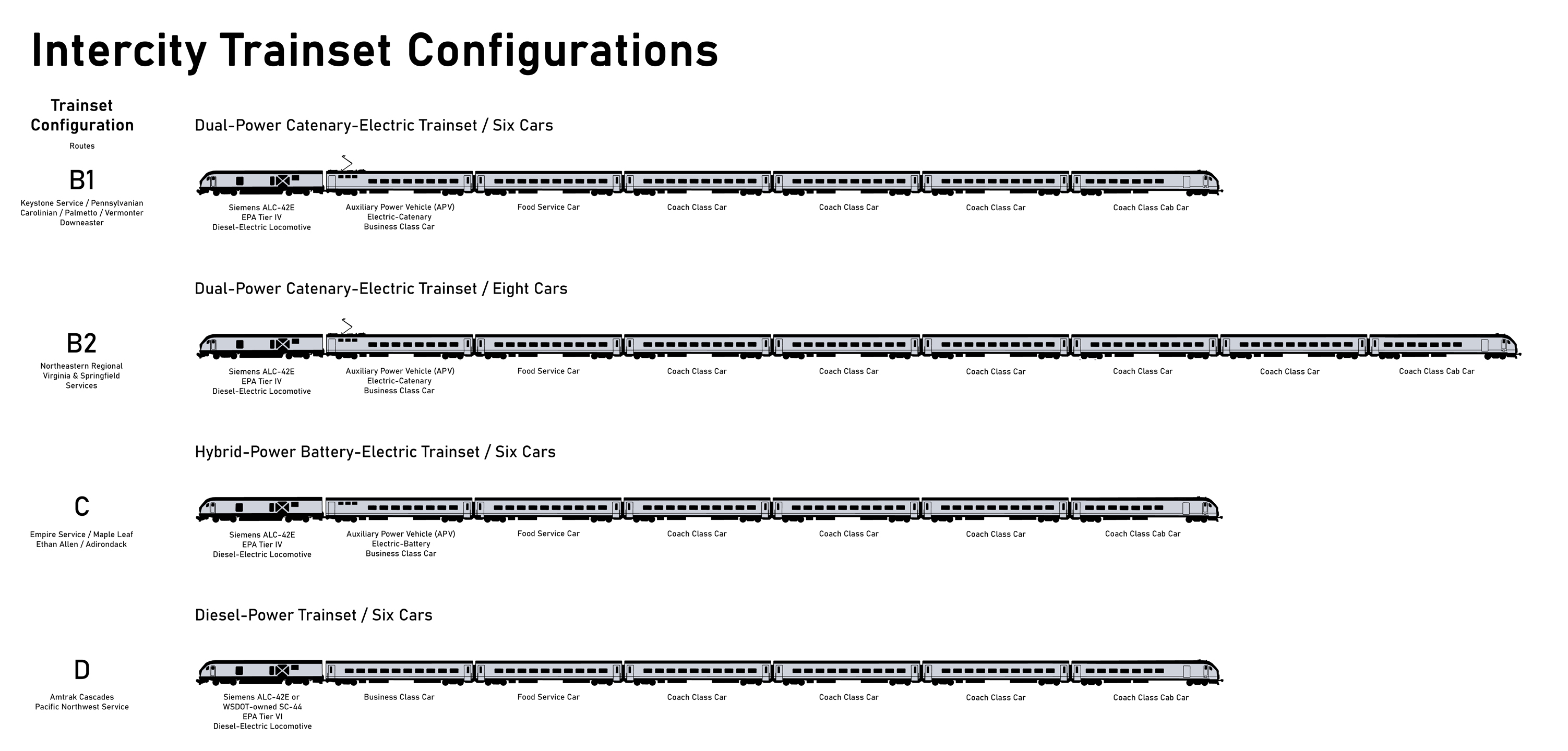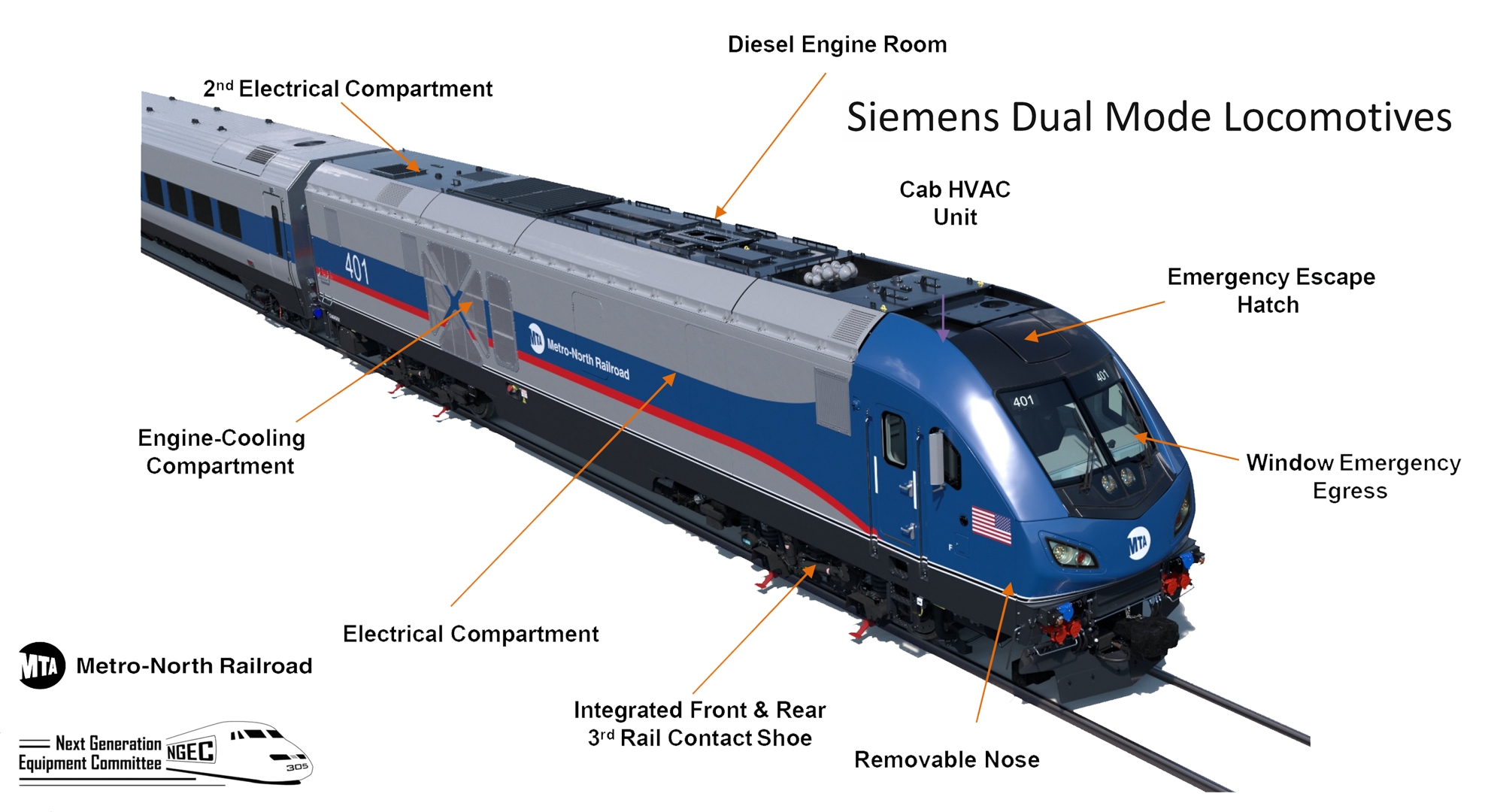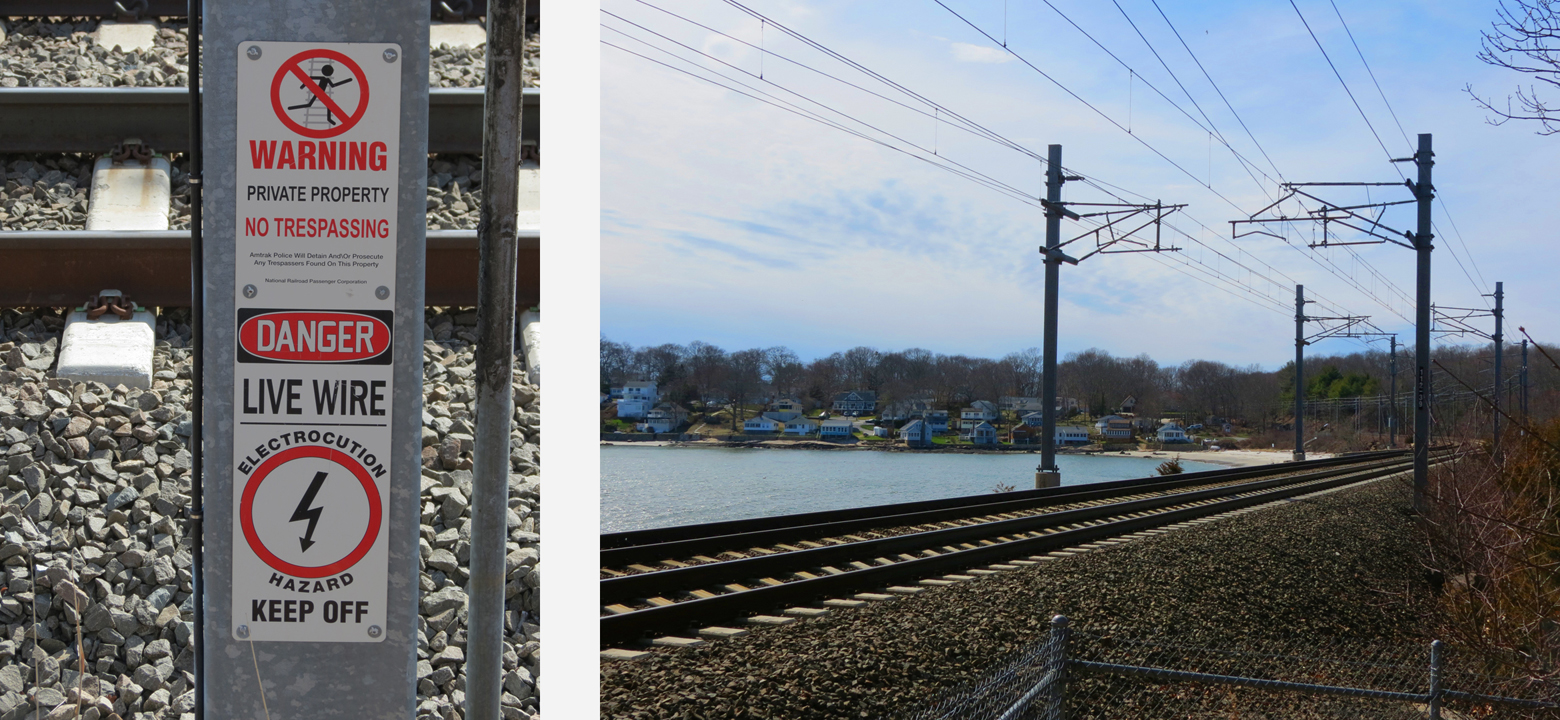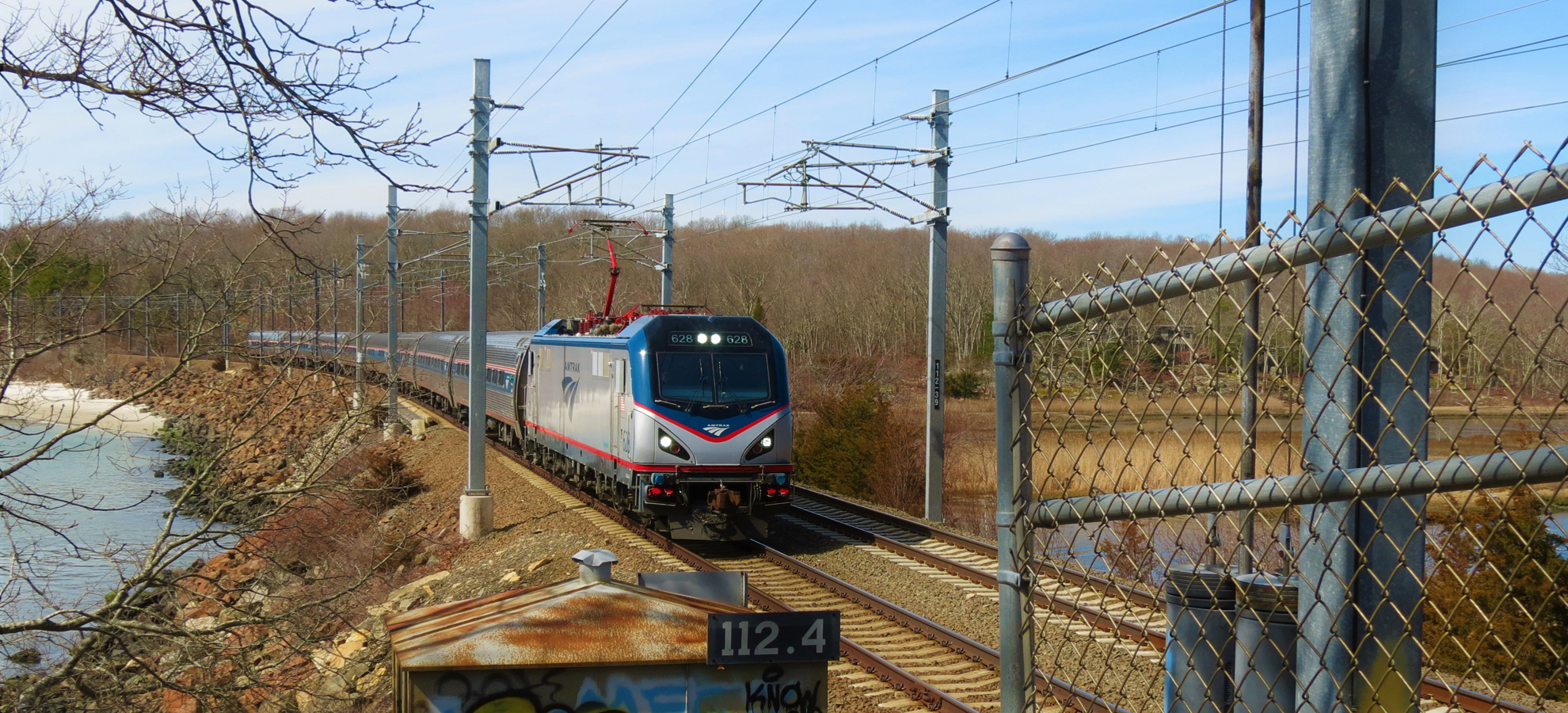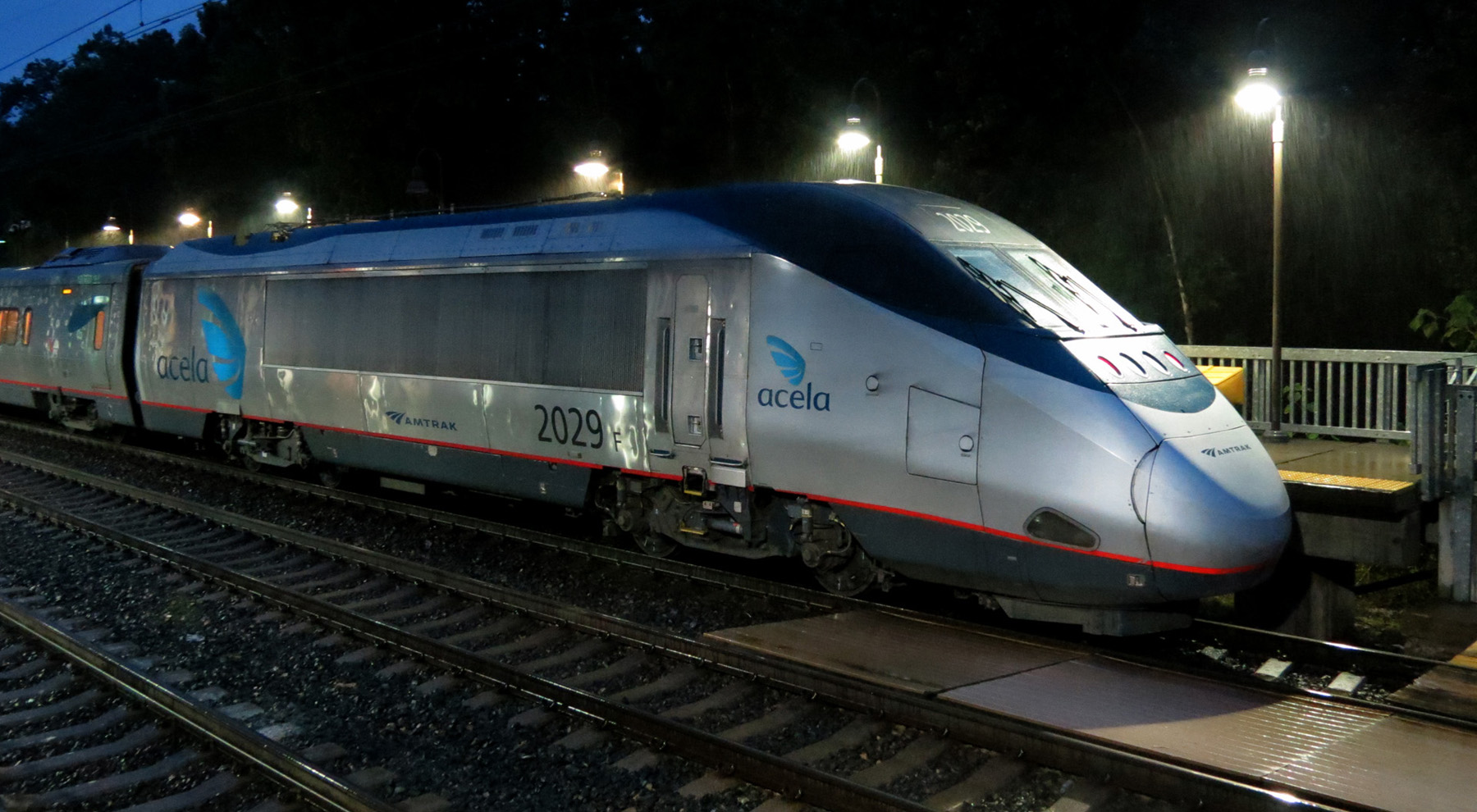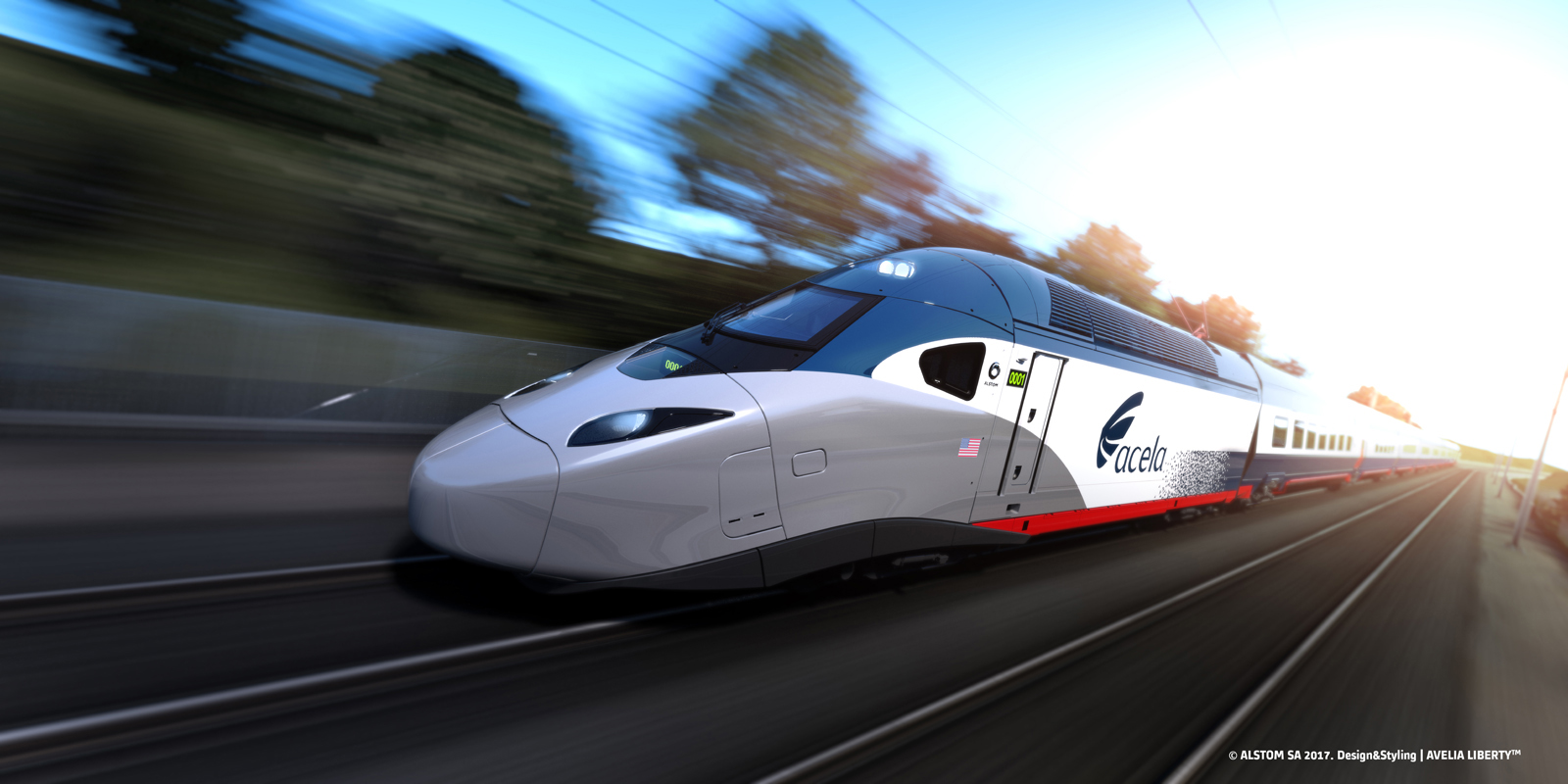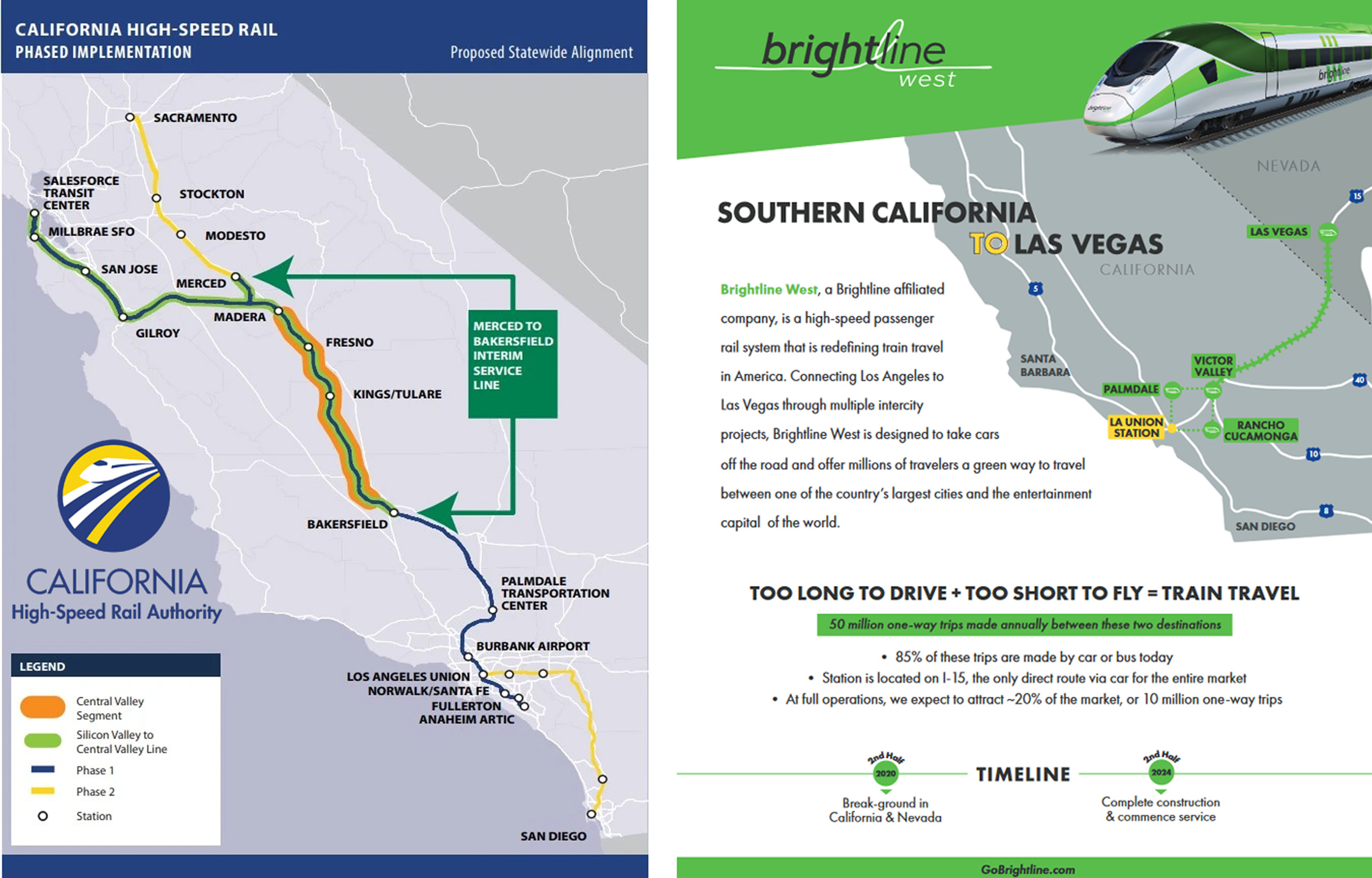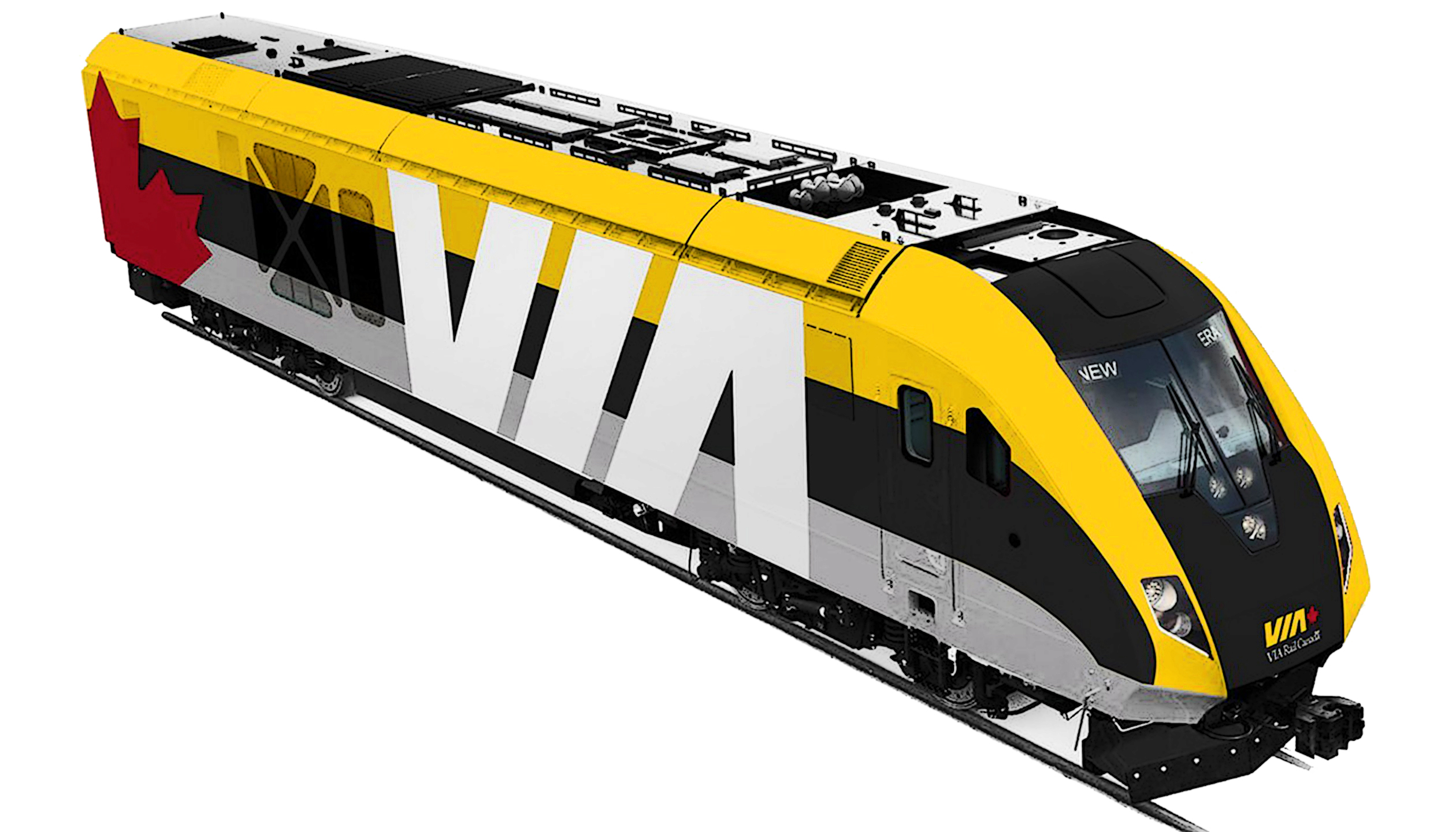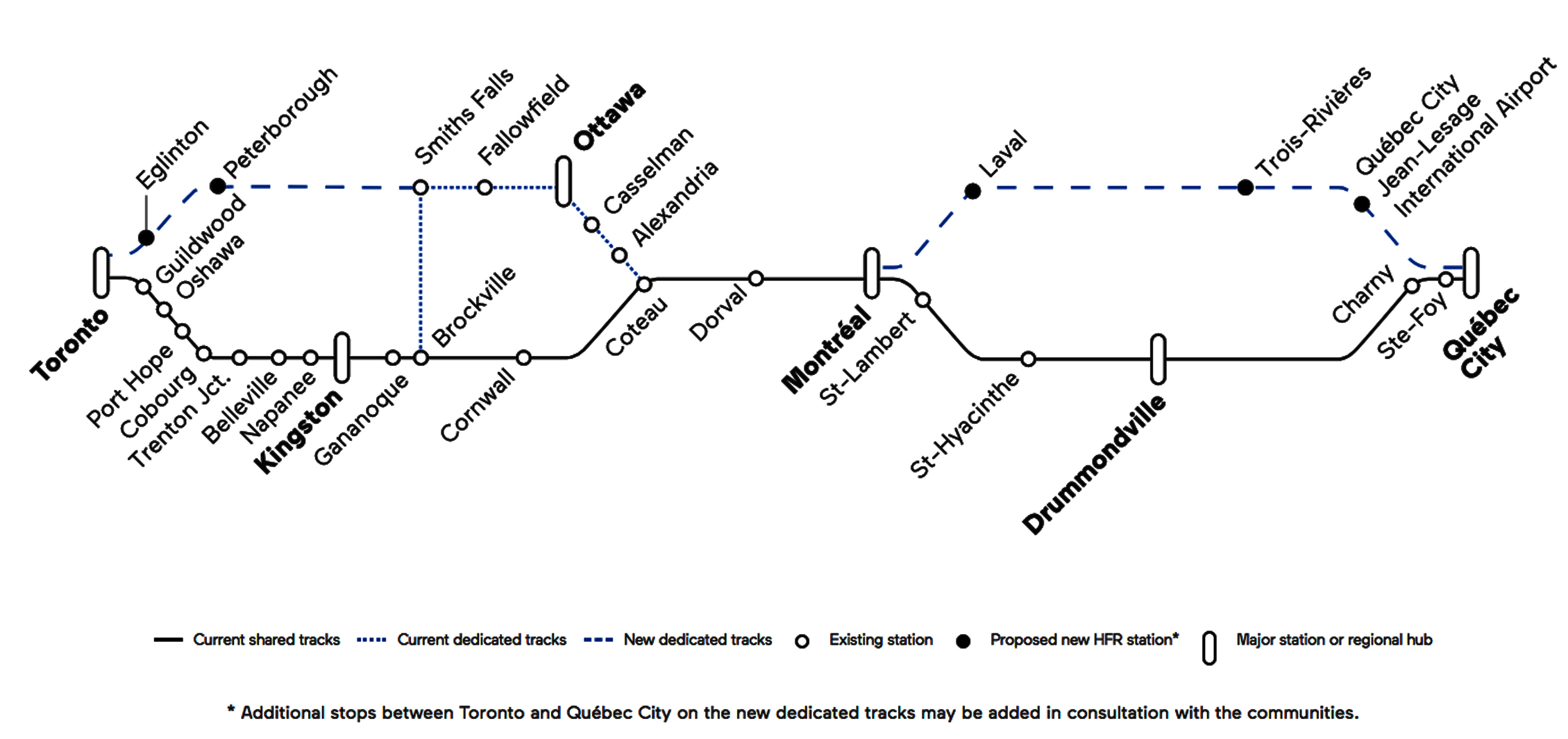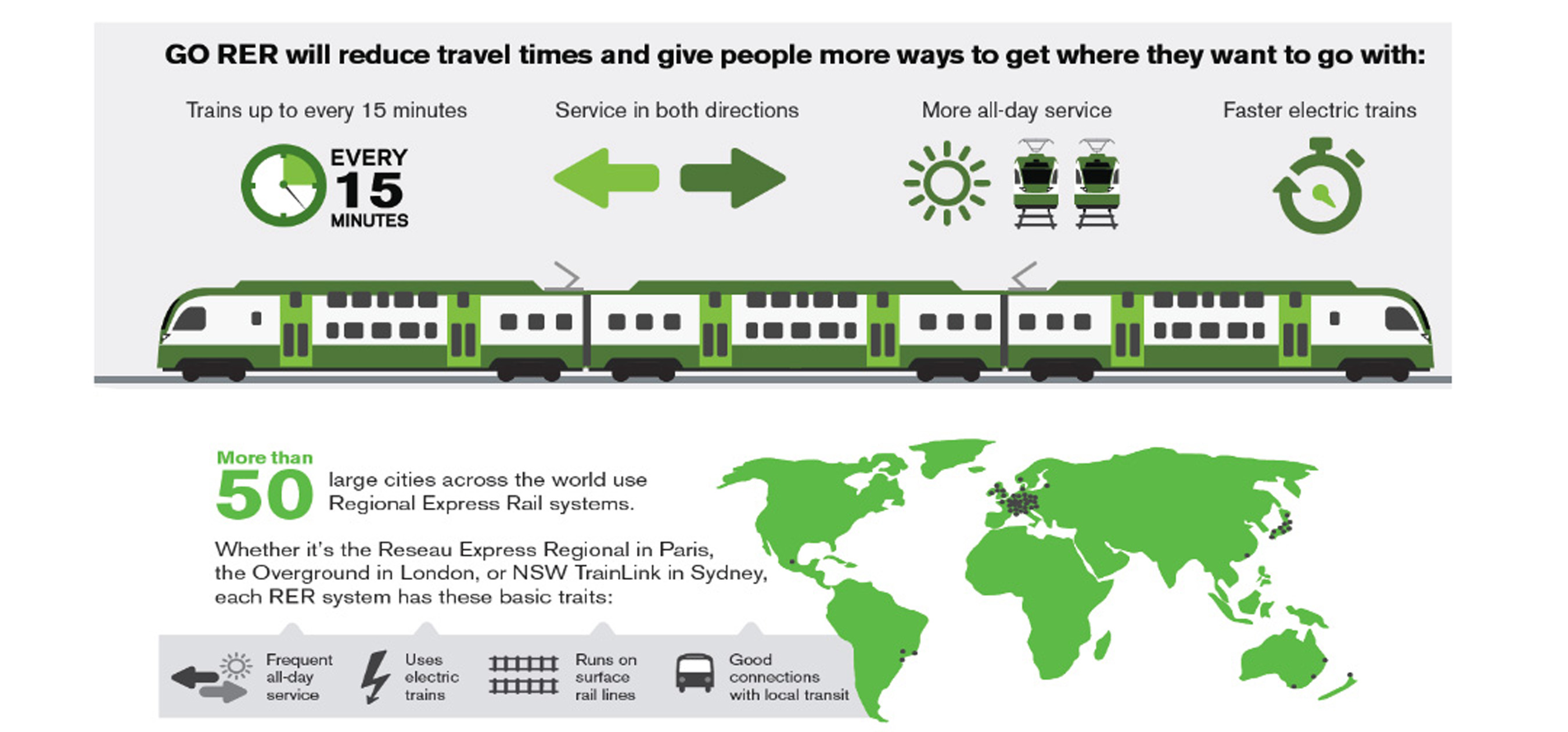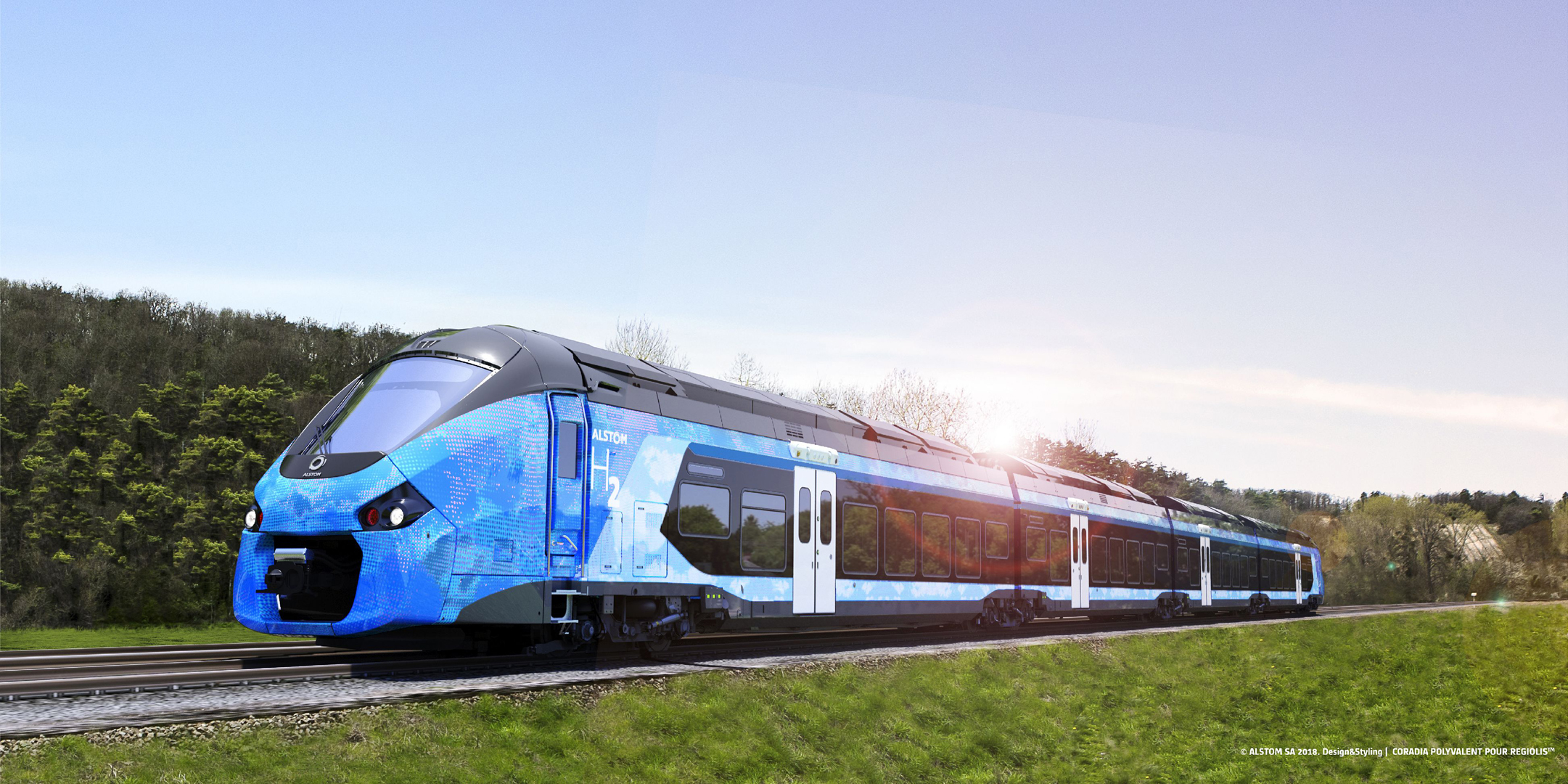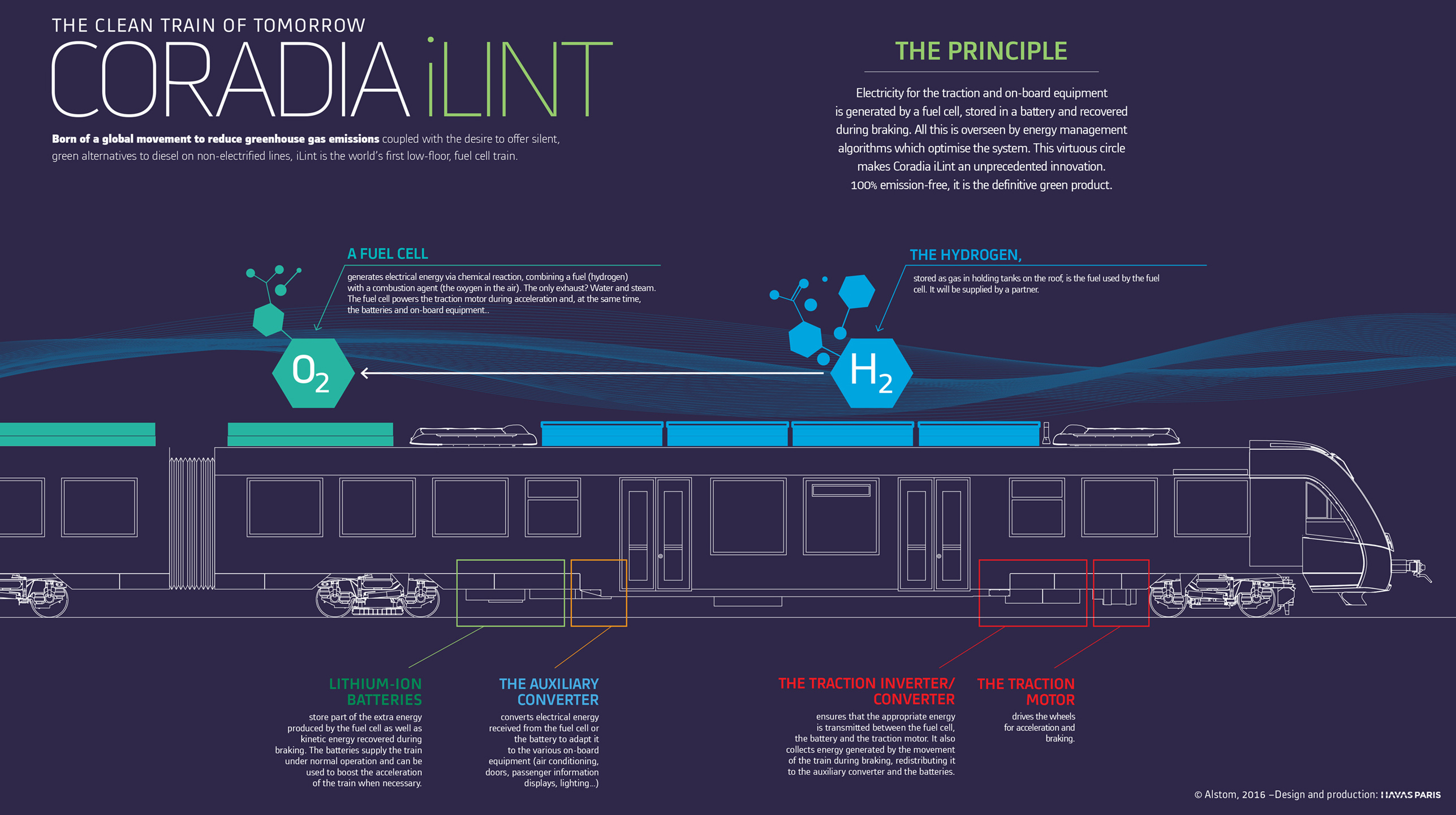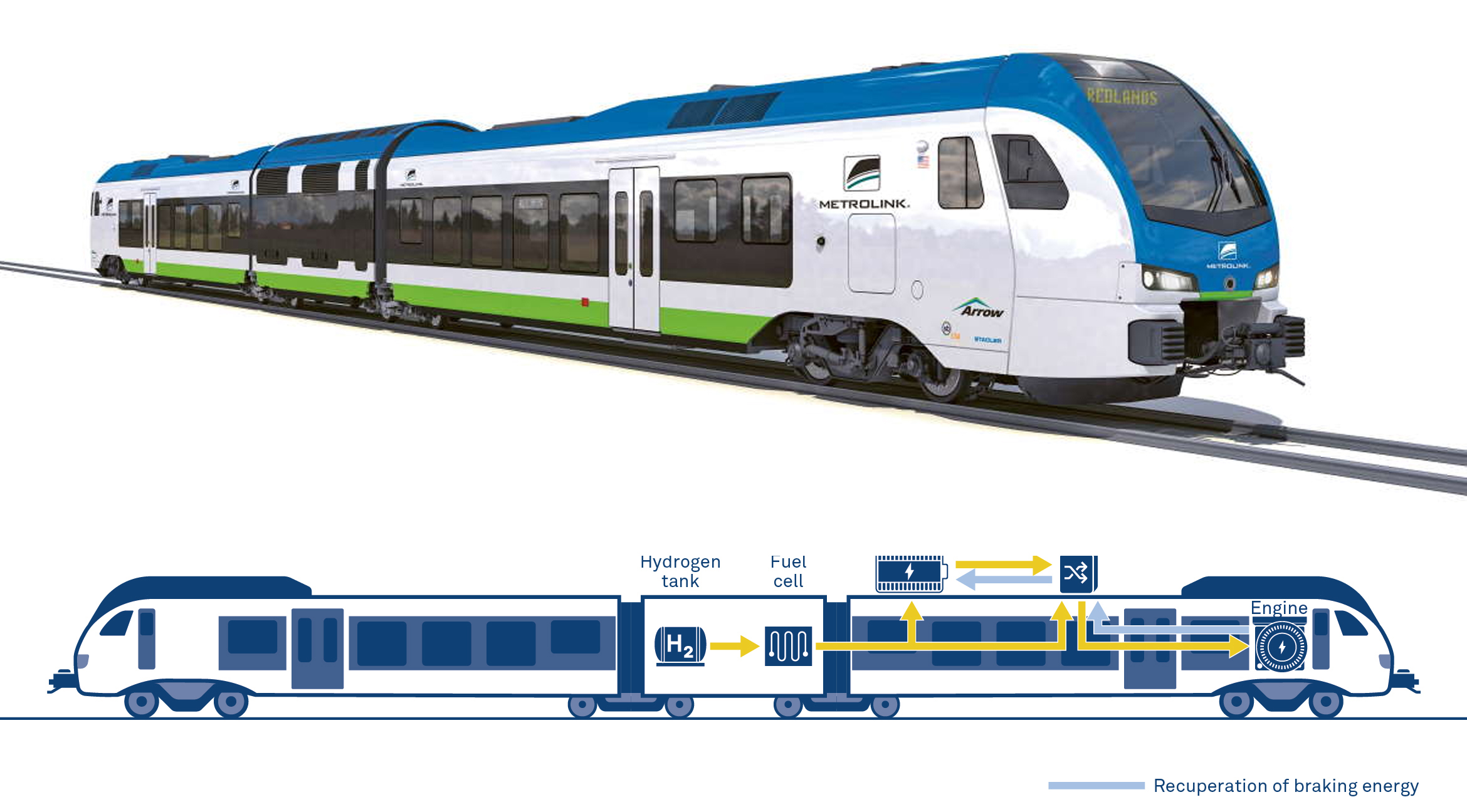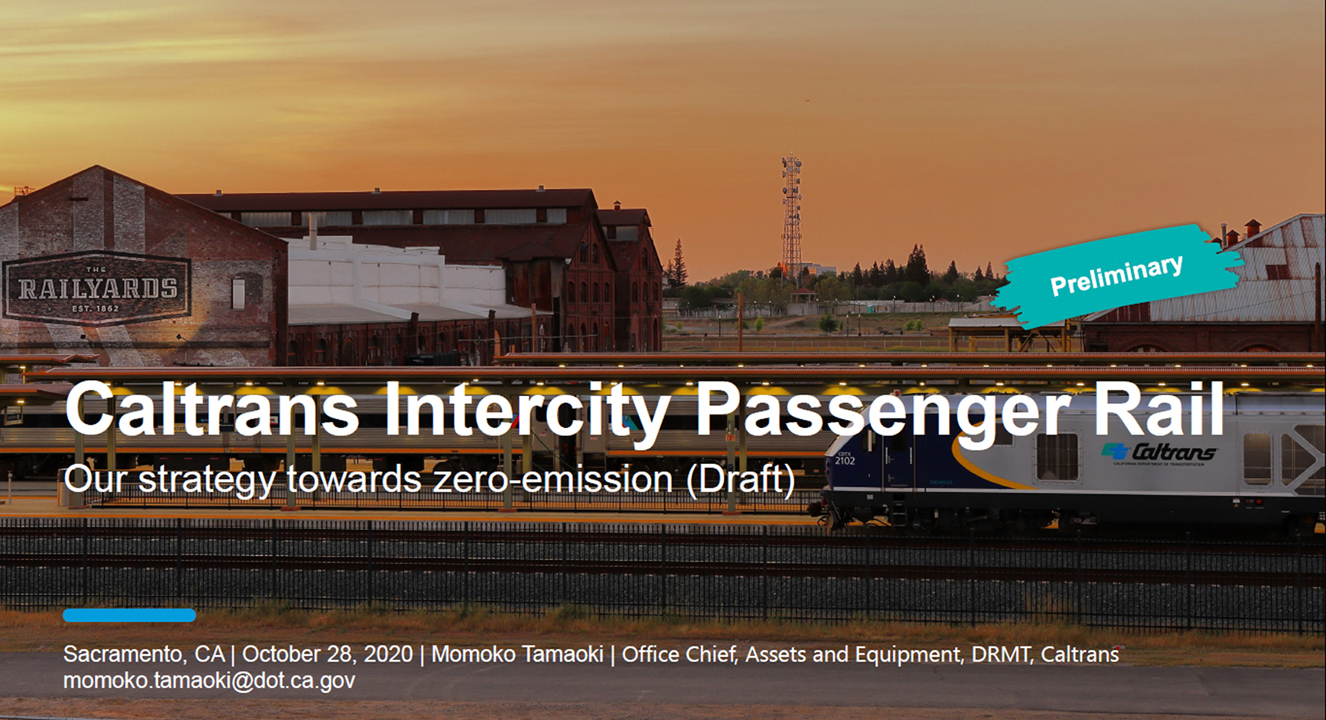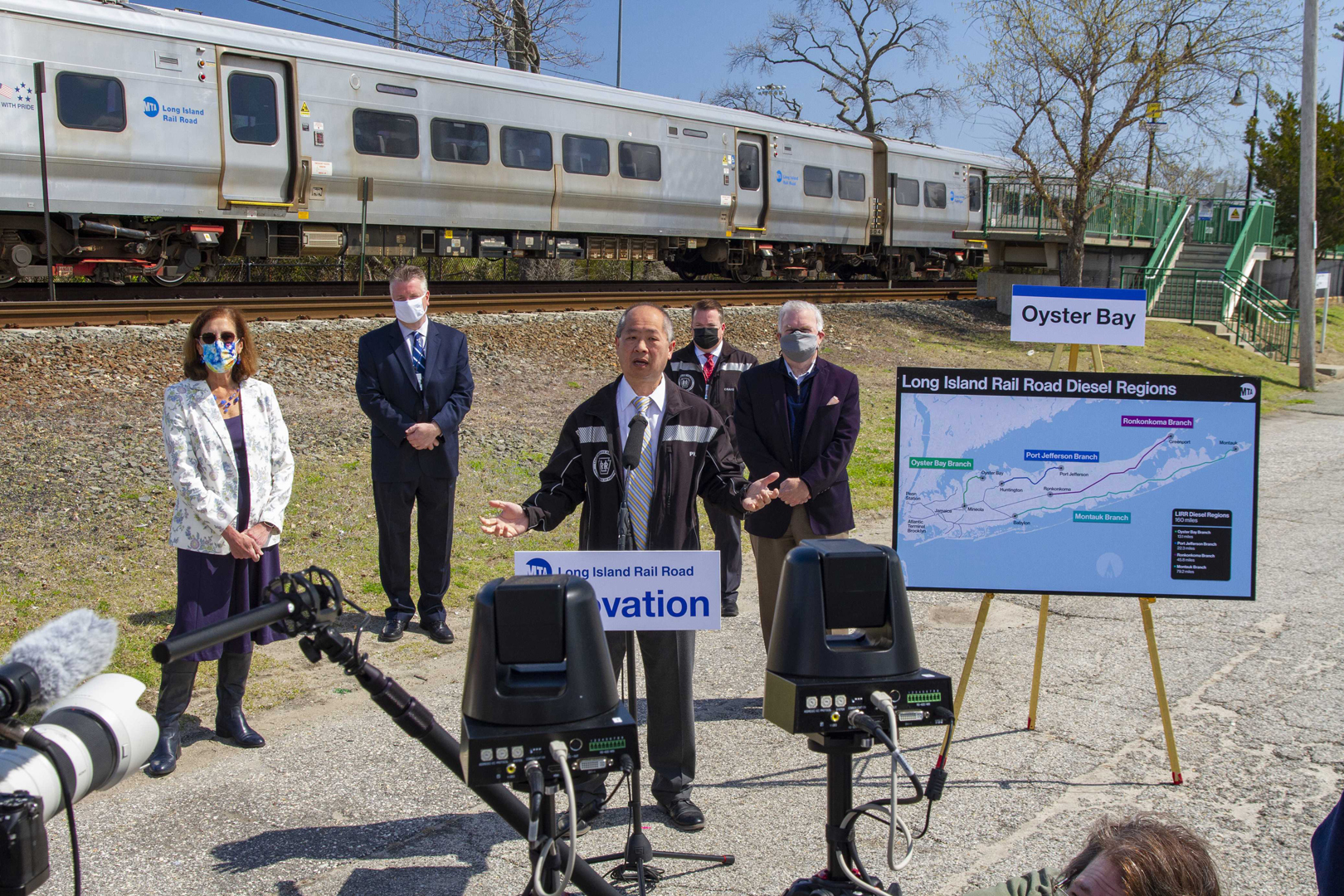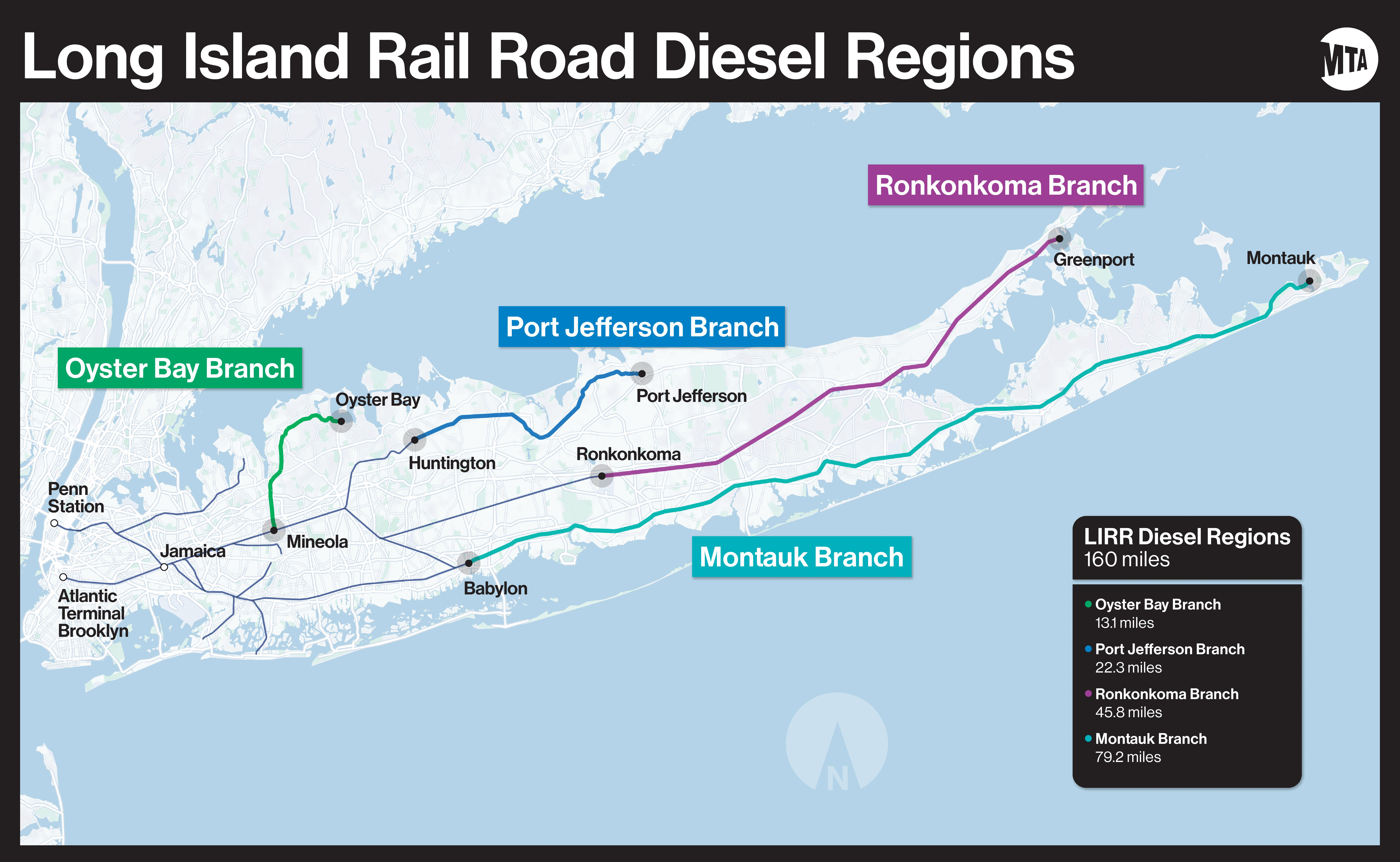Climate Change and Rail
Climate Change and Passenger Rail
Solutions & Case Studies for Getting Passenger Rail in New York State to Zero Carbon Emissions
-
The Need to get Passenger Rail to Zero Emmissions
-
Meeting Climate Goals with Passenger Rail
-
Diesel-Electric Hybrid 'Airo' Trainsets for the Empire Corridor
-
Railroad Electrification
-
Northeast Corridor Electrification
-
Caltrains Electrification and the California HSR Projects
-
VIA High Frequency Rail
-
GO Transit Regional Express Rail
-
Malaysian West Coast Electrification Double Track Project
-
Hydrail: Hydrogen Fuel Cell-Electric Trains
-
Battery Trains on the LIRR ... or Not
New York State Climate Act
The Need to get Passenger Rail to Zero Emissions
New York State with the passage of the Climate Leadership and Community Protection Act in Spring 2019 took a bold step in becoming a leader in confronting the growing danger of global warming. The Climate Act mandates that the state move to a net-zero emission economy by 2050 by eliminating most emissions of greenhouse gases – primarily CO2 – from the burning of fossil fuels.
The Climate Act mandates that the state all but eliminate its greenhouse gas emissions by 2050 through the elimination of the burning of fossil fuels in power generation and transportation. The goal is by 2050 to cut greenhouse gas emissions to 85% of 1990 levels, with the remaining 15% offset by reforestation, wetland creation, or carbon capturing through technological means. A 22-person “climate action council” composed of top state officials, who will be advised by smaller working groups with expertise in specific areas from forestry to economic development.
The state’s climate bill is nearly identical to legislation passed in the United Kingdom. The Climate Change Act of 2008 calls for net UK greenhouse gas emissions for the year 2050 to be at least 80% lower than the 1990 baseline. Concerning transportation, the current policy of the British government is for all new passenger cars and vans sold in the UK to be zero emissions vehicles – either battery electric, plug-in hybrid electric or hydrogen fuel cells. For the rail sector, transport minister Jo Johnson in 2018 called for all diesel trains to be phased out by 2040.
With one-third of New York State’s emissions being from transportation, both freight and passenger rail will have to be addressed. For rail transport the most obvious answer to going carbon neutral is electrification, an over century old technology that today is in extensive use moving both heavy freight trains and high-speed passenger trains around the globe. However, there are three other alternatives to the current diesel motive power of most American trains, that of trains propelled by batteries, hydrogen fuel cells, and electricity taken in directly from overhead wires called the catenary. When the electricity that charges batteries, produces hydrogen, and energizes the overhead catenary is produced from renewable energy – from hydro, wind, solar, and nuclear power generation – you can have a zero emission train.
We will show how new green motive power is being developed around the world and how this existing and new technology can be incorporated into our state’s passenger rail system, creating a sustainable transport service for the 21st century and beyond. It is vital that New York State – through the Climate Action Council, NYSDOT, and the New York State Energy Research and Development Authority (NYSERDA) – began the process to decarbonize rail transport, including commuter rail, intercity rail, and freight rail.
While other states – California being the leader – are moving forward with planning studies and demonstration projects for zero emission trains, New York State has yet to do so, beyond one project for the Long Island Railroad for battery trainsets, which was then canceled. This needs to change, if passenger rail is to remain the most environmentally friendly mode of mass transportation, with diesel hauled Amtrak, Metro-North, and LIRR trains in New York State will need to be replaced by the 2030s with zero emission motive power.
Passenger Trains: An Energy and Climate Solution
Meeting Climate Goals with Passenger Rail
Better Land Use
Passenger Rail encourages Sustainable Cities through walkable higher density development and urban renewal through “transit-oriented development” around stations, many of which along the Empire Corridor are located in historic urban centers. The Preferred Alternative 90B (Empire Corridor Tier One EIS) by utilizing existing railroad infrastructure and right-of-way, will preserve farmland and the wildlife habitat of forests and wetlands, while also reducing carbon emissions during construction by avoiding excessive tree cutting and excavation of earth.
Transit Oriented Development
-
TOD: Transit Oriented Development Institute
-
Intercity Rail and Transit-Oriented Development: Making Connections, Building Communities
-
Housing trend focuses on downtown train stations: The trend is called 'transit-oriented development' - here's where it's breaking out across the Lower Hudson Valley.
-
Brightline’s New Orlando Route Signals Florida's Potential Transit Future: Developers and Investors Eager for Sites Around State's Six Train Stations
Low Carbon Fuels
Renewable Biogas could be low-carbon alternative fuel for diesel locomotives. Biogas is a methane fuel produced from decaying organic waste sourced from landfills, sewage treatment plants, and farms. According to the California Energy Board, biogas has the lowest greenhouse gas emissions of readily available alternative fuels, reducing greenhouse gas emissions by 30 to 70 percent on average, and by up to 125 percent compared to petroleum-based fuels. The organic matter used to produce biogas will naturally decay and release greenhouse gases into the atmosphere, so using this methane – from landfills, sewage treatment plants, and farms – as a fuel dramatically reduces its climate impact by converting it into CO2, which is up to 34 times less potent as a greenhouse gas. That released CO2 will then be absorbed by feed crops for farm animals, whose organic waste can be once again converted to fertilizer and biogas. Existing diesel locomotives can have their diesel engines modified to use methane gas – as the Florida East Coast Railway has done for the last decade with its fleet of LNG freight locomotives. Considering Upstate New York’s large dairy and horse racing industries – perhaps there is a sustainable synergy that can be established between our state’s farm industry and intercity passenger rail services.
IMAGE CREDIT: Amtrak Capital Corridor | CCJPA EYES RENEWABLE DIESEL TO POWER TRAINS FOR A SUSTAINABLE FUTURE
Renewable Biodiesel could be\ the best low-carbon alterative to fossil fuel diesel. Currently the passenger locomotives of Brightline Florida and California’s state-supported Amtrak services – the Surfliner, Capitol Corridor, and San Joaquin – are now fueled with biodiesel derived from commercial kitchens. Biodiesel significantly reduces greenhouse gas emissions by over an estimated 60 percent; while also reducing other harmful emissions, including fine particulates and nitrogen oxides, leading to improved local air quality. Renewable Diesel combined with new Siemens Airo-Venture Trainsets hauled by EPA Tier IV Siemens Charger locomotives – which reduce Particulate Matter (PM) by 95% and Nitrogen Oxides (NOx) by 89% compared to the EPA Tier 0 standard of older diesel locomotives – represents the most pragmatic step to dramatically reduce the air pollution and carbon emissions of Empire Corridor trains in the near future.
Renewable Biodiesel
Long Term Solutions?
Electrification with Overhead Catenary is a possible long-term solution, yet it is not pragmatic at this time, due to the great cost and complexity of electrification, and that such a mega-project that would require the dramatic expansion of institutional capacity within NYSDOT for intercity rail planning and project management. The freight railroads, including CSX, are also on record has being opposed to electrification of their rail lines. However the electrification of publicly controlled tracks of Amtrak, Metro-North, and the LIRR with sufficient funding and organizational expansion is an entirely feasible long-term goal. This includes electrifying the Hudson Line from Croton-Harmon (were existing third rail operation ends) to Hoffmans (where the Amtrak line joins the CSX mainline to Buffalo west of Schenectady) which is controlled by Metro-North and Amtrak, and thus the opposition of the freight railroads is mute. With Amtrak this decade placing new dual-mode Airo trains into service on the Northeast Corridor (NEC) that can run off the overhead catenary of the NEC and onboard diesel engines for service beyond the wires, the same could be done for the Empire Corridor.
Hydrogen Fuel Cells are another possible long-term solution, but they are also not pragmatic at this time due to the immaturity and uncertainty of hydrogen propulsion for railway locomotives. With the need to get the new Siemens Airo trainsets ordered by Amtrak for the Empire Corridor in service as soon as possible, now is not the time for delay or experimentation. However, the combination of dual-mode trainsets utilizing both overhead electric catenary and onboard hydrogen fuel cells could get Empire Corridor trains to net-zero carbon emmissions.
California Electrification and Hydrogen Projects
-
Caltrain Electrification | Program Overview
-
Caltrans Intercity Passenger Rail | Our strategy towards zero-emission
-
Hydrogen power is coming down the track for California's rail fleet
-
California Continues to Expand Hydrogen-Powered Passenger Rail Fleet
Siemens Mobility to Build New Trains for Amtrak
Image Credit: Amtrak Press Kit
Diesel-Electric Hybrid 'Airo' Trainsets for the Empire Corridor
The Charger locomotives built by Siemens Mobility at their Sacramento plant in California are the first high-speed passenger diesel locomotives to receive Tier 4 emissions certification from the Environmental Protection Agency (EPA). The locomotive is powered by a high-performance, environmentally friendly, 4,400 horsepower-rated Cummins QSK95 diesel engine, designed to operate at speeds up to 125 miles per hour.
The Charger locomotives are equipped with electronically-controlled regenerative braking systems that use energy from the traction motors during braking to feed the auxiliary and head-end power systems to minimize fuel consumption. With a fuel capacity of 2,200 gallons, the locomotive consumes more than three times less fuel than comparable gallons per passenger for two-person car travel. The newest The QSK95 Cummins engine in the locomotives provide a 16% improvement in fuel efficiency over the non-Tier 4 certified locomotives that the Charger will replace.
The first Chargers entered service in January 2018 for Brightline – a new privately led passenger rail service in Florida – hauling new Siemens Venture trainsets which they double-ended, with two locomotives on each end of the bidirectional trainsets. Later Charger locomotives were delivered to power Amtrak corridor services in California, the Midwest, and the Pacific Northwest. Amtrak has also ordered seventy-five SC-44 Charger diesel locomotives for $850 million designed for long-distance service, replacing aging power in its National Network locomotive fleet, engines that haul overnight trains like the NYC-Boston-Chicago ‘Lake Shore Limited’. In Canada its national public intercity passenger rail company VIA Rail has placed a larger order for new Siemens Charger-Venture trainsets for its Ontario and Quebec “Corridor” service.
In July 2021 Amtrak signed a $3.4 billion contract with Siemens Mobility for a new fleet of up to 83 multi-powered "Intercity Trainsets" (ICT) made up of integrated ALC-42E Charger-Venture Coach trainsets, which will be utilized for state-supported corridor and Northeast Corridor services, with further options for up to 130 additional trains to support Amtrak growth plans. Deliveries are slated to commence in 2024. For Amtrak, its total investment, with a long-term parts supply and service agreement, facility modifications and upgrades, and contingencies, is $7.3 billion. The new equipment includes dual-power (AC catenary/diesel) locomotives for the Northeast Corridor (NEC) and first-of-their-type Venture Hybrid battery trainsets. The eight trainsets for the Cascades in the Pacific Northwest will include a to-be-built ALC-42E or in-service SC-44 Charger locomotive and six passenger cars.
YouTube | Introducing Amtrak Airo – A New Era of Rail
In December 2022 at a press conference in the Moynihan Train Hall at Penn Station, Amtrak President Roger Harris and other officials introduced the new brand name — Airo — for the Siemens Charger-Venture intercity trainsets of semi-permanently-coupled coaches making up the fleet of 83 trainsetsthat would replace Amfleet coach consists for the corridor services in the Northeast, Southeast, and Northwest United States. “As we invest in the future, Amtrak is leading the way with a new era of rail,” said Amtrak President Roger Harris at the media event. “Our new trains will transform the Amtrak experience with significant environmental benefits, a progressive design and world-class amenities.” President Harris also stated that the new Airo trainsets would first enter service in 2026 on the Cascades route connecting Oregon, Washinton State, and British Columbia before being rolled out for Eastern Coast corridors.
Fact Sheet | Amtrak Airo: Built by America
Image Credit: Siemens Mobility
SOURCE: Amtrak's “Service & Asset Line Plans for FY22-27
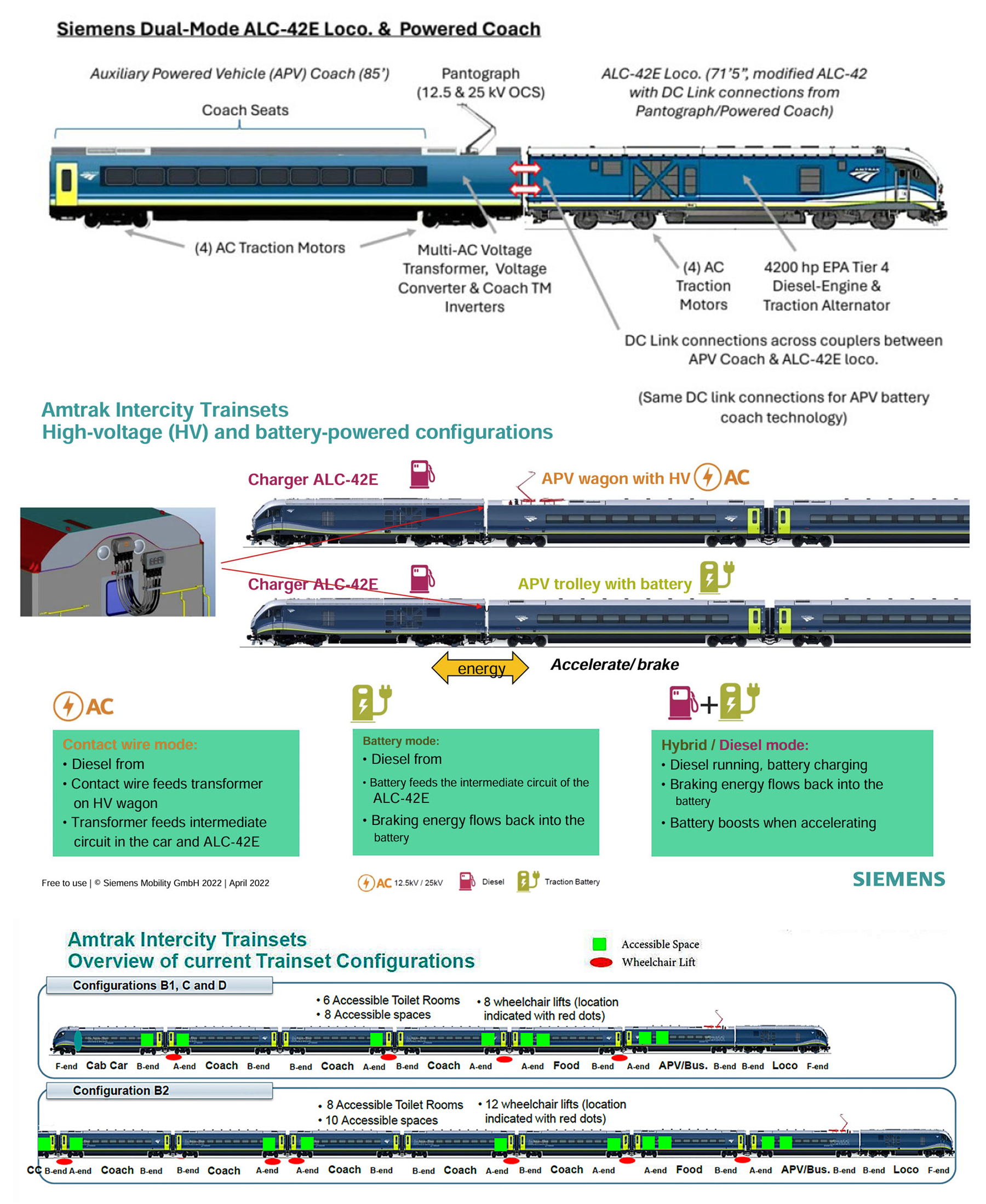
SOURCE: Siemens Mobility via YouTube videos and FRA documents
Coach and Business class interiors of Amtrak's new 'Airo' Siemens Charger-Venture Trainsets | Image Credit: Amtrak Press Kit
Northeast Regional, Downeaster, Vermonter, Pennsylvanian, Palmetto, Carolinian, and Keystone services will utilize a fleet of 50 dual-mode diesel-electric trainsets, consisting of an ALC-42E locomotive and six (state corridors) to eight passenger (NEC) cars, including an Auxiliary Power Vehicle (APV) adjacent to the locomotive that will have a pantograph to supply power from overhead catenary to the traction motors in the locomotive and an additional powered truck of the APV coach. The dual-power trainsets will operate on the Northeast Corridor where they will eliminate the need for lengthy engine changes for trains traveling beyond the electrified catenary of the Northeast Corridor – particularly into Virginia – reducing travel times considerably.
The new dual-mode trainsets will surprisingly mostly supplant the still very new Siemens ACS-64 City Sprinter all-electric locomotives that entered service in 2014; currently hauling non-Acela trains between Boston, New York, Harrisburg, and Washington. A few Sprinters would remain to haul long-distance trains under the wires, the railroad hoping to sell the rest of the Sprinter fleet to regional commuter railroads, although electric-multiple-units (EMU) would seem to be a better fit for the frequent stop-and-go of commuter service. Also, pure electric locomotives would be more energy efficient than dual-modes hauling the dead weight of diesel engines and fuel tanks – and trains continuing beyond the electrified NEC are a minority of all ‘Northeast Regional’ trains running under the wires.
Empire Corridor trains today [as of 2022] are primarily hauled by a fleet of Amtrak owned dual-mode diesel-electric locomotives equipped with electric Third Rail DC capability that enables trains from Upstate NY to enter the non-diesel electric territory of Penn Station and the East River tunnels to Amtrak's Sunnyside Yard in Queens. Acquired by Amtrak from General Electric in the 1990s, the current fleet of 18 P32AC-DM Genesis locomotives are after very intense utilization surpassing their 20-year service lives – they’re old, tired, and occasionally catch on fire – and need replacement sooner than later. The average failure rate in service for the dual-mode locomotive fleet is increasing, leading to more frustrating delays for passengers. ESPA has long believed that a dual-mode locomotive replacement order by Amtrak and New York State (NYSDOT).
ESPA has long believed that a dual-mode locomotive replacement order by Amtrak and New York State (NYSDOT) should be combined with an order from Metro-North, which is now moving to replace its own fleet of P32AC-DMs that operate to Poughkeepsie, a joint Amtrak-Metro-North saving New York taxpayers' money and speeding delivery to Amtrak of the much need new motive power. However, we now know that Intercity Trainsets will replace the Empire Corridor's existing fleet of P32AC-DMs and Amfleet coaches.
Dual-mode locomotives allow Amtrak trains to run under third-rail electric power into Penn Station and Grand Central.
Empire Service, Maple Leaf, Ethan Allen, and Adirondack will utilize a fleet of fifteen (with an option for two more sets) hybrid battery trainsets for used on New York State’s Empire Corridor services connecting New York City with Upstate NY, Vermont, and Canada. These trainsets will like the NEC trainsets have a Siemens diesel-electric ALC-42E Charger (the diesel engine providing the power for the traction motors) mated to rake of six semi-permanently coupled Siemens Venture coaches with streamlined fronted cab car at the other end of the set containing a control cab. The APV adjacent to the locomotive will contain a big battery pack to supply electrical power when operating in Penn Station (and Grand Central Terminal if needed in the future), eliminating the current use of third rail by the existing eighteen GE P32AC dual-mode engines. A prototype set is planned to be available for testing by 2025, with the rest of the trainsets being delivered by 2030.
The battery power will enable the diesel-electric trains to run in the underground tunnels of Penn Station and Grand Central Terminal off electrical power, with the diesel engine switched off. The large battery replaces the use of third rail power today by the current fleet of General Electric P32AC-DM Genesis dual-mode locomotives that haul Empire Corridor trains. Amtrak therefore avoids the cost of using of power from the third rail DC power of the LIRR (over-running third rail) and Metro-North (under-running third rail), and the complication of the two different types of third rail used by the two commuter railroads, which requires the switching of third rail shoes on the current P32AC dual-modes when trains are diverted from using one terminal to the other Manhattan station. If in the future Amtrak is required to temporarily divert Empire Corridor trains from Penn Station (as in 2017 and 2018) or expand service to Grand Central, then the hybrid-battery trainsets will simplify the operations.
When operating in diesel mode, the new trainsets for the Empire Corridor will meet EPA Tier IV emissions standards, the battery power may also further boost the fuel efficiency of the diesel-electric train as with hybrid motor vehicles, reducing emissions further. The trainsets have modern train interiors, including onboard electronic signage, vestibules, lighting, and restrooms. Amtrak’s trainset project team is currently working with Siemens on the final design elements, including livery, and interior furnishings. The trainsets will also meet or exceed all requirements of the Americans with Disabilities Act (ADA) for new-build equipment, replacing legacy equipment which was built prior to the ADA’s passage and not designed for accessibility on which various accessibility elements were added during overhauls.
Introducing Amtrak Airo
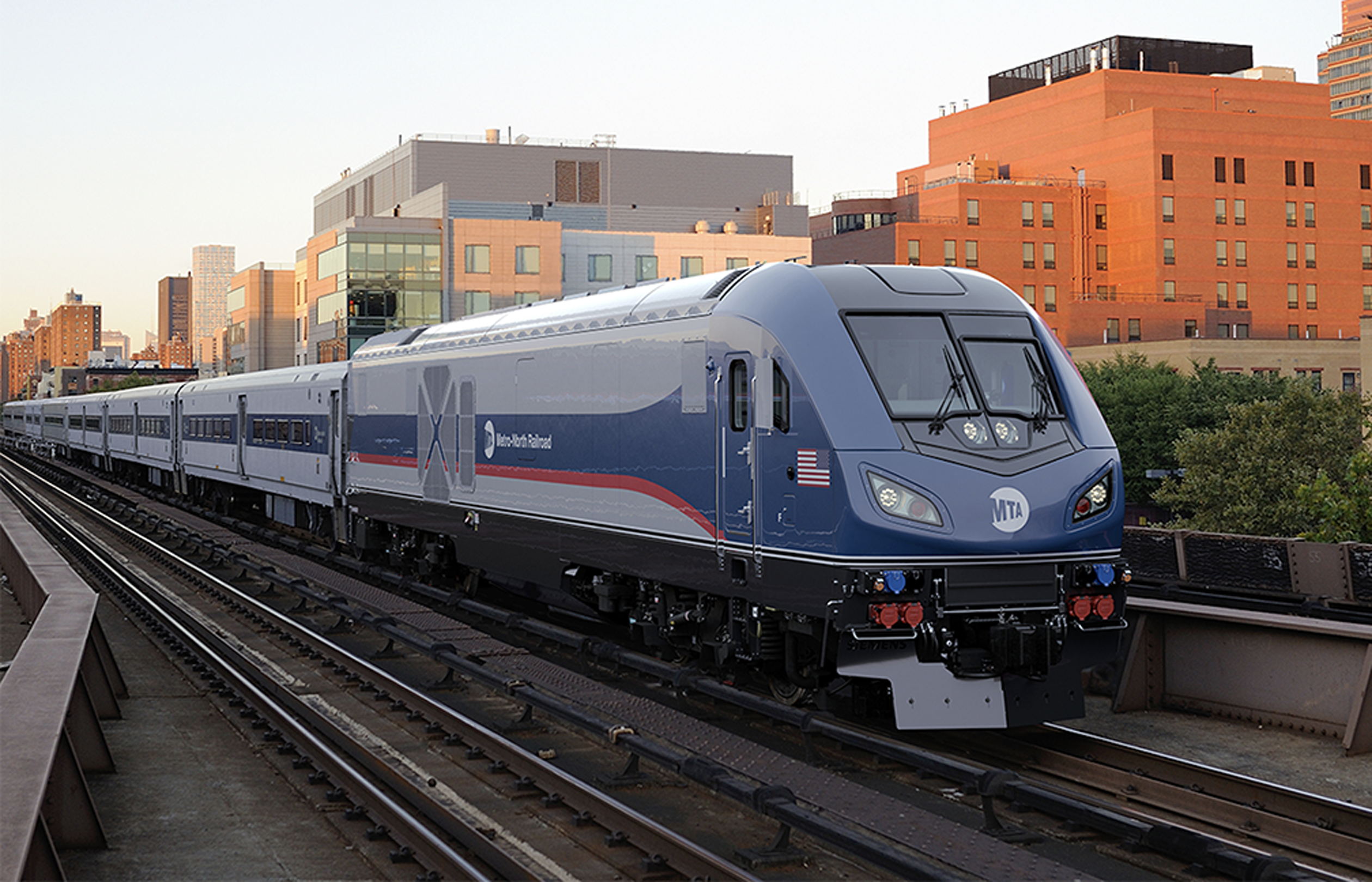
Image Credit: Siemens Mobility
New Dual-Mode Locomotives for Metro-North
In December of 2020, the MTA Board approved awarded a $335 million contract to Siemens Mobility for the design and manufacture of twenty-seven new dual mode locomotives, the first in a new line of engines on a contract that includes options for up to 144 additional locomotives. Much like the P32AC-DM was a direct successor of the P40DC/P42DC locomotives mass produced for Amtrak's use nationwide, Metro-North's new dual mode (if awarded) would also be a direct successor to the ongoing Siemens Charger program, which has been in production since 2016.
As part of the RFP process, Siemens did not bid the base specifications, but instead provided an alternative design based on Siemens' standard Charger locomotive platform already in operation, customized to meet Metro-North's crucial technical requirements. Metro-North spent 18 months negotiating with Siemens and reviewing the alternative design to come up with the ultimate specifications and the contract terms for the order. Included in the original phase 1 RFP were several design options that could be included as part of the final contract, including:
- A diesel and DC third rail dual mode with a top speed of 110 mi/hr or 125 mi/hr (instead of 90 mi/hr)
- A diesel and AC overhead wire locomotive with a top speed of 110 mi/hr or 125 mi/hr (similar to NJTransit's ALP-45DP locomotives)
- A DC third rail and AC overhead wire motor (no diesel) that can run on 25 c/s 12.5 kV, 60 c/s 12.5 kV, and 60 c/s 25kV overhead wire
Alstom Coradia Polyvalent: New Green Solutions
Railroad Electrification
The most straightforward solution to achieving zero-emissions of greenhouse gases for rail transportation is electrification, where trains receive power directly from a trackside third rail (as in the NYC Subway, Metro-North, and LIRR) or from overhead wires called the catenary. The modern railway electrification system using alternating current (AC) at 25 kilovolts (kV) was developed by the French after WWII in the 1950s and since has become the global standard used worldwide, especially in new high speed railways.
In comparison to unelectrified railways utilizing diesel motive power, electric railways offer substantially better energy efficiency, lower emissions, and lower operating costs; all the while electric traction also being quieter, more powerful, responsive, and reliable than diesel traction. Electric traction systems often have regenerative braking, turning the train's kinetic energy back into electricity that is returned to the supply system for use by other trains or the broader utility grid. Electric trains can utilize power generated from diverse sources, including renewable energy such as wind, solar, and hydro.
With well over a century of electric train operation – including in New York City where mainline and rapid transit electrification was pioneered – this is the proven “off-the-shelve” solution. From the Tokyo Subway to 200-mph high speed trains in France to 9000-ton ore trains above the Arctic Circle in Sweden electric traction is equally capable of freight, passenger, and urban transit applications. Switzerland and Sweden in the early 20th Century lacking domestic supplies of coal and oil were nations early to electrify their mainline railways, with today 100% of the Swiss rail system being electrified. After WWII led by France and Japan, several nations of Western Europe and East Asia followed with extensive electrification programs. The Soviet Union and Peoples Republic of China also have extensively electrified their rail networks; 85% of all rail freight in Russia moves by electric train.
Today other nations are following suit including Malaysia which over two decades has electrified its commuter railways around Kuala Lumpur while electrifying, double-tracking, and grade-separating its 715-mile long West Coast Mainline from the Thai border to Singapore, replacing diesel hauled trains with a fast and frequent service of modern EMU trainsets. Many other nations from Morocco to Indonesia are building new electrified high-speed railways. India is now undertaking the construction of “Dedicated Freight Corridors'', a project to build over 2000 miles of double-track electrified dedicated-freight rail lines across the subcontinent, where 15,000 metric ton 200-car long double-stack intermodal trains will race along at 60-mph behind powerful 12,000 HP electric locomotives. The development of the record 7.5 meter “High Reach” pantograph will not only allow double-stack intermodal trains, but when used on other lines for double-deck passenger trains.
North America has become an outlier with the amount of electrified railway having greatly decreased since WWII, despite the United States being the world leader in rail electrification leading up to WWII. This is the result of America’s railways being largely privately owned and the historic abundance and cheapness of oil produced in North America. Almost all the mainline electrification before WW2II was installed to solve the problem of the smoke of steam locomotives in urban and mountain tunnels, the high horsepower of electric locomotives being an additional plus for dealing with heavy mountain grades. The result was that while America led the world in the milage under wires, it was discontinuous and accounted for a small minority of all milage for the continental rail wide system. With the coming of diesel-electric locomotives (the onboard diesel engine powering the electric traction motors) and more effective tunnel ventilation the private railroads decided it was more economical to eliminate their few electrified segments and instead maintain a standardized fleet of diesel locomotives that could run anywhere. By the 1980s only a few commuter railways, some short line mining railroads, and Amtrak's NYC-DC Northeast Corridor remained electrified.
Overseas governments during this Postwar period where in contrast willing to fund the high upfront capital costs of electrification of their state-owned railways in return for the long-term benefits in lower operating costs, greater capacity, and energy independence. This has not proven to be the case in North America even for publicly owned commuter railroads. While California is now electrifying its Caltrain service between San Francisco and San Jose, this is the first major electrification project since Amtrak’s New Haven-Boston electrification in the 1990s. In fact, it can be argued that in North America there is now a rail industry culture that is outright hostile to electrification. The Association of American Railroads (AAR) in their white paper “Freight Railroads & Climate Change” proposed “market” solutions as opposed to “mandates” and called for more “innovation” in developing low and zero carbon emission technologies: including biofuels, batteries, and hydrogen fuel cells in lieu of electrification. The AAR’s paper stated that:
“As policymakers examine potential solutions, they should invite stakeholders to the table to provide needed insight and prevent the wasting of resources. While AAR encourages federal investment in the development of technologies that reduce GHG emissions, policymakers should avoid prescriptive means for reducing emissions by certain industries and allow innovation to guide GHG emissions reduction decisions. For example, studies over the years have consistently shown that the catenary electrification of the freight rail network would be unworkable. Initiatives, such as catenary electrification, that are clearly not viable should be set aside to focus on and invest in policies and programs that will work to reduce GHG emissions and combat climate change, such as those noted above.”
Still despite this strong anti-electrification opinion by the broader rail industry, this there are several electrification projects now underway or being planned in North America on heavily trafficked passenger railroads that are publicly owned and funded. In New York State where there is both extensive public ownership of mainline railroads by the Long Island Rail Road, Metro-North, and Amtrak and a considerable mileage of track already electrified, electrification is an option that should seriously be considered. However due the complexity and high costs of electrification, it would be beyond prudent to look at case studies from around North America and overseas so best to learn lessons from them and then apply best practices in any future electrification project.
Electrifying the Railway
Northeast Corridor Electrification
The Northeast Corridor (NEC) is a 457-mile railway line connecting the highly urbanized “megapolis” of the Northeastern United States, connecting Boston, New York City, Philadelphia, Baltimore, and Washington DC. The NEC is the busiest passenger rail line in the United States both by ridership and by service frequency with more than 2,200 trains daily: including Amtrak’s premier Acela Express, Northeast Regional, Keystone Service, and several long-distance trains. Overall Amtrak intercity passenger ridership in FY2019 was 12.5 million, with tens of millions more commuters.
The rail line was built between 1830 and 1917 while being merged into the Pennsylvania Railroad and the New York, New Haven, and Hartford Railroad. Electrification was done in stages from the opening of New York’s Penn Station in 1905 to the completion of mainline electrification between New York, Philadelphia, Harrisburg, and Washington. The New Haven’s electrification was completed by 1914, ending at New Haven, Connecticut. Locomotives were switched at New Haven between steam and electric locomotives. The multiple unit commuter trains had to run off both the New Haven’s overhead 11 kV AC catenary and the 750 V DC of Grand Central Terminal. In the 1950s the New Haven introduced the dual-mode FL9 diesel-electric locomotive to eliminate the engine change at New Haven.
The high quality of the passenger service and density of population generated high ridership into the 1960s while passenger ridership collapsed across the rest of the nation. With the example of the opening of the Tōkaidō Shinkansen in Japan in 1964, the “Bullet Trains” inspired the Metroliner Project funded by the High-Speed Ground Transportation Act of 1965, one of the first high-speed rail services in the world. After the bankruptcy of Penn Central (formed from the 1968 merger of the Pennsylvania, New York Central, and New Haven railroads) the newly created Amtrak took intercity passenger services in 1971 and acquired most of the right-of-way of the Northeast Corridor in 1976, with portions in New England having been previously bought by the state governments of Connecticut and Massachusetts. The federally funded Northeast Corridor Improvement Project (NECIP) was initiated in 1976 to modernize the line: including grade separation, upgrading of signaling systems, installation of new centralized electrification and traffic control (CETC) centers, and introduction of AEM-7 locomotives and Amfleet coaches.
ABOVE: The current generation of Acela trainset at BWI Airport Station on the Northeast Corridor
The Northeast High Speed Rail Improvement Program (NHRIP) was implemented on the line in the 1990s to expand electrification from New Haven to Boston, while also eliminating grade crossings, rebuilding bridges, and realigning curves for higher speed. Heavy continuous welded rail (CWR) was laid down with concrete railroad ties replacing wood ties. Electrification with modern AC 25kV catenary of 157 miles of mainline track began in 1996 and was completed in 2000, with electric haulage between New Haven and Boston beginning on January 31, 2000. Amtrak on December 11th 2000, began operating its higher-speed Acela Express service which replaced the premier Metroliner service, using its new Acela tilting high-speed trainsets built by Bombardier and Alstom. Top speed for the Acela is 150-mph on two short segments in New England, with long sections of 125-to-130-mph running for both the Acela and Regional trains between Boston and Washington. The total project cost was $2.3 billion: $1.3 billion for the infrastructure improvements, and the rest for both the new Acela Express trainsets and the Bombardier–Alstom HHP-8 locomotives.
Last decade the Federal Railroad Administration completed the Tier 1 environmental impact statement study in 2016 for the NEC Future master plan for developing the corridor through 2040. The Selected Alternative proposes the further modernization of the existing NEC to bring it to a state of good repair and while undertaking several major infrastructure expansions to reduce travel times, increase train frequency, and improve on time reliability. A key project is the Gateway Program to build new tunnels under the Hudson River into Penn Station to add capacity and allow the two existing century old tunnels to be rebuilt. In July 2021 the Northeast Corridor Commission released a15-year vision for the Northeast Corridor, including 150 projects with a combined cost of $117 billion.
In 2016 Amtrak ordered 28 Avelia Liberty trainsets – part of the Avelia family of high-speed trains of French rail manufacturer Alstom – for use on its flagship Acela service, replacing the now 20-year-old original Acela trainsets. The Avelia Liberty trainsets will allow for improved frequency and greater capacity on the Acela service, including half-hourly peak service between New York City and Washington DC; the new trainsets having a total capacity of 386 passengers (378 seats and 8 wheelchair locations in nine coaches) which is a quarter more than the existing Acela trainsets. The new trains feature active tilt technology that will initially allow faster service on the curving tracks between New Haven and Boston, while upgrades to the 1930s catenary will allow speeds up to 160 mph south of New York to Washington.
Amtrak will pay off the $2.45 billion federal loan paying for the new trainsets, as well as some select infrastructure improvements from increased NEC passenger revenue. Assembly of the American-built trainsets is taking place at Alstom's plants in Hornell and Rochester, New York – with as of summer 2021 two trainsets being completed and being put through testing at the Transportation Technology Center in Pueblo, Colorado and along the Northeast Corridor. The new Avelia Liberty trainsets are expected to enter revenue service as Acela trains beginning in spring of 2022.
BELOW: The next generation of Acela trainset for the NEC, the Alstom Avelia Liberty, built in Hornell, NY (Image Source: Alstom)
Amtrak's Next-Generation of High-Speed Rail
Caltrains Electrification and the California HSR Projects
The Caltrain Modernization Program is a $2.3 billion project electrifying with 25 kV AC overhead catenary lines – with additional modernizing (including installing Positive Train Control) components –the existing 51-mile San Francisco-San Jose mainline of the commuter railroad Caltrains, which serves communities of the San Francisco Peninsula and Silicon Valley. As part of the transition to an electric railroad most of its current diesel-electric locomotive hauled trains of double-deck coaches will be replaced with new European 110-mph six-car double-deck electric multiple units (EMU) built by Stadler Rail in Salt Lake City.
The electric trains will stop and start faster than diesel trains, allowing Caltrain to increase capacity with a more user-friendly and efficient schedule providing a consistent and attractive service, with more frequent stops not sacrificing overall travel times. Electric motive power will also reduce local and regional air pollution while allowing a transition to zero-emission transport with green electric power sources. The project received funding as part of the California High Speed Rail Project and as part of the “Blended System” plan will allow future high-speed trains to reach the new San Francisco Transbay Transit Center. Construction commenced in July 2017 with completion of the project now projected in 2024.
ABOVE: The planned routes of the California High Speed Rail Project (left) and Brightline West (right)
Other major electrified passenger rail projects in California include the before mention and under construction California High Speed Rail Project and the in planning Brightline West project to build a new high speed rail service from Las Vegas to the Los Angeles Metro region. The California High-Speed Rail (CAHSR) is a publicly funded and highly controversial high-speed rail project (due to numerous cost overruns, missed construction deadlines, and lawsuit after lawsuit) that has been decades in the planning and under actual construction for about a decade. Its goal is to connect the Anaheim and Union Station in Downtown Los Angeles with the Salesforce Transbay Transit Center in San Francisco via the Central Valley – where construction is underway – with a initial operating segment opening sometime this decade, connecting Bakersfield and Fresno. Next will be building across the Coastal Ranges to San Jose to the north, and then across two other mountain ranges to the south into Los Angeles. Trains will travel up to 220-mph and take less than 3 hours to cover the 380 miles between Los Angeles and San Francisco.
Brightline West is an affiliate of the privately owned and managed Brightline, the Miami-West Palm Beach-Orlando intercity rail passenger company. Brightline West will connect the 260 miles between Las Vegas and Los Angeles with an expected travel time of about 3 hours utilizing 200-mph zero-emission electric train sets. The railway will have connections to Metrolink and other regional transit options and planned future connection to California High Speed Rail in Palmdale. Brightline West is cooperating with Los Angeles County Metropolitan Transportation Authority (Metro), the San Bernardino County Transportation Authority, and Caltrans (California DOT) on the mutually beneficial High Desert Corridor, a high-speed rail project that would connect Palmdale and San Bernardino. Construction is expected to begin soon with service commencing mid-decade.
Electrification and the Future of Caltrain
VIA High Frequency Rail
The Quebec City–Windsor Corridor is the most densely populated and heavily industrialized region of Canada with more than 18 million people – about half the nation’s population – living in eight of Canada's twelve large metropolitan areas, including Toronto, Montreal, and the national capital of Ottawa. It is in this over 700 mile stretch of geography that Canada’s national passenger train operator VIA Rail – a Canadian Crown corporation that operates intercity passenger rail service in Canada – runs its only multi-frequency intercity rail services, with 36 daily trains carrying over 4.7 million annual passengers.
However as result of having to share track owned primarily by freight rail companies, the ‘Corridor’ services suffer from lengthy journey times, limited frequency, and poor on-time performance, constraining the operating and financial performance of VIA Rail compared to modern intercity rail services along Amtrak’s Northeast Corridor and overseas in Europe and Asia. In response to these challenges, VIA Rail developed and submitted a “higher speed rail” proposal in 2016 to the Government of Canada. After Transport Canada, Infrastructure Canada, Finance Canada, the Canada Infrastructure Bank – working with VIA Rail – conducted an in-depth assessment of “High Frequency Rail” proposal, in July 2021 the Liberal Party government of Prime Minister Justin Trudeau committed to the VIA Rail plan.
The High Frequency Rail proposal in the Toronto to Quebec City Corridor involves building dedicated electrified passenger rail tracks on unused freight railroad right-of-way that would be rebuilt for 110-to-124-mph operation (177-to-200-km/h) by dual-mode diesel-electric trainsets, like those that Amtrak as contracted with Siemens Mobility to acquire for its Northeast Corridor services. VIA Rail is already taking delivery of 32 new Siemens diesel trainsets (Charger locomotives + Venture coaches) to replace the overage equipment of its existing corridor services, so a logically a second order could follow for dual-mode trainsets from the California (Siemens Mobility’s North American operations) based company.
This estimated $4.8 billion USD ($6 billion CAD) higher speed rail megaproject would be cheaper than previously proposed very high speed rail (160-to-220-mph) projects while providing many key benefits to travelers, including: (1) shorter travel times and faster trains that would reduce average trip times between Toronto and Ottawa by up to 90 minutes, to as low as 3 hours and 15 minutes from current travel times of approximately 4 hours and 30 minutes.; (2) more reliable on-time arrival performance up to 95% from a current average of 67%; (3) more direct routes with improved connectivity between cities and to other modes of transportation; (4) new services to certain communities, such as Peterborough, Trois-Rivières, and Laval, and new stations in targeted locations including near Jean Lesage Airport; (5) more frequent departures between cities; and (6) a cleaner travel option using electrified technology.
It is expected that High Frequency Rail could nearly triple the number of annual trips taken by rail in the Toronto to Quebec City Corridor, rising from 4.8 million in 2019, to a projected 17 million by 2059. With over 90% of the route between Quebec City and Toronto electrified, trains would be largely powered by carbon-free energy from Quebec’s abundant hydroelectric capacity. On the new route diesel traction would only be necessary for the short segments where the trains would run over the unelectrified tracks of freight railroad CN. Station stops along VIA Rail’s existing CN route along Lake Ontario and the St. Lawrence River would continue to be served by local schedules tuned to the needs of communities between the big cities, with Kingston becoming the terminus for regional trains to and from Montreal and Toronto.
VIA High Frequency Rail
GO Transit Regional Express Rail
GO Transit Regional Express Rail is a decade-long $13.5 billion (CAD) megaproject to provide metropolitan Toronto with a efficient high capacity and frequency regional rail service like those seen in megacities like Paris, London, and Tokyo. It is one of the 'Big Move' rapid transit projects of Metrolinx, a Crown agency of the Government of Ontario that manages and integrates road and public transport in the Greater Toronto and Hamilton Area.
A key part of the project is the electrification of 163 route miles of railway line, including the full electrification of the Lakeshore East line, Stouffville line and the Barrie line and the partial electrification of the inner portions of the Lakeshore West line and the Kitchener line. There will also be an additional 93 miles of new track, including bridges and tunnels. New four-car bi-level electric multiple unit (EMU) sets will be acquired, coupled to form 8 and 12-car trains during peak periods, and 4-car trains during periods of lighter demand, such as weekends. The existing fleet of unpowered bi-level coaches will be hauled by new electric locomotives. The use of hydrogen fuel cell powered trains was considered but rejected in favor of overehead electrification with 25 kV AC catenary.
The new services will have a frequency of every 15 minutes or more on most lines. The faster acceleration of the EMUs over existing diesel trains will allow for a reduction in travel times while reducing operating expenses. Overall GO Transit will see an increase in the number of train trips per week from 1,500 (2015) to 6,000 weekly trips upon completion, most of the extra trips occurring during the off-peak hours and on weekends as GO Transit rail service goes from a commuter to rapid transit pattern of service. The expanded services, new infrastructure, and electrification is projected to roll out in phases between 2025 and 2030.
GO Expansion | Project Assessment Process
Malaysian West Coast Electrification Double Track Project
Starting in 2008 the Malaysia government began incrementally in large sections electrifying, double-tracking, realigning, and grade-separating it’s 715-mile West Coast Line – northward from the capital Kuala Lumpur to the Thai Border and then southwards towards Singapore. Malaysia has spent about $6.3 billion USD over 15 years to completely rebuild its British colonial era meter-gauge (3 ft 3 3⁄8in) mainline – formerly a single-track railway through the jungles, rubber plantations, and rolling hills of the countryside – into a modern higher-speed electric railway utilization the global standard 25 kV AC railway electrification.
The introduction of the new fast and frequent “ETS” (Electric Train Service) utilizing 100-mph electric multiple unit (EMU) trainsets has resulted in double-digit growth of intercity passenger rail ridership – up to 7.2 million annual passengers in 2018 – for the national railway KTM (Keretapi Tanah Melayu Berhad). While the mainline was rebuilt for 100-mph service (160-km/h) the express intercity trains currently run at 87-mph (140-km/h), placing them among the fastest narrow-gauge trains in the world. If the railway had been rebuilt as a standard gauge (4ft 8½in) line, then commercial speeds as high as 125-mph would be completely feasible.

Work on the last $2.4 billion 122-mile section from the Gemas (important rail junction city) to Johor Bahru (city opposite Singapore) is now underway, with completion expected in October 2022. With trains averaging about 60-mph (100 km/h) the ETS travel time between the capital city Kuala Lumpur and Johor Bahr – which is across the bridge from Singapore and part of Malaysia's third largest urban agglomeration – will be four hours, a cut from the current seven hours of diesel trains. The ETS will provide an attractive alternative to express intercity motorcoaches, which currently require four-and-a-half hours to travel between the two cities even without traffic congestion. It also will be a consolation for the termination of the controversial Kuala Lumpur–Singapore high speed railway which was to have a 90-minute travel time. The future Johor Bahru–Singapore Rapid Transit System will provide a rail transit connection to the city state of Singapore from the future ETS terminous station of JB Sentral.
The completion of the double-track electrification program is expected to be a catalyst that will spur economic development in the central part of the State of Johor by allowing residents living in towns along the route to be able to commute daily to Johor Bahru. Completion will also facilitate large-scale cargo shipments between Malaysia’s two largest ports, Port Klang near Kuala Lumpur and Tanjung Pelepas west of Johor Bahru. While there are questions on how well the new electrified railway will commercially compete against cars, buses, and trucks on Malaysia’s well developed highway system, they have created a high capacity, high speed, and zero-emission transport backbone for the nation.
EDTP: The Journey of Connectivity
The Coradia iLint is the world’s first commercial operating passenger train powered by a hydrogen fuel cell. Photo: Alstom
Coradia iLint
Alstrom's dual-mode Coradia Polyvalent H2 trainset for regional service in France by SNCF Voyageurs. Image: Alstrom
The First Hydrogen Train in France
Hydrail: Hydrogen Fuel Cell-Electric Trains
The emerging zero-emission alternative to standard railway electrification with overhead AC catenary is Hydrail– the portmanteau of hydrogen and rail transport – where onboard hydrogen fuel cells replace the diesel prime mover of a diesel-electric locomotive or railcar to produce electricity that powers the traction motors that propel the wheels. The world’s first commercially built hydrogen powered train, the Coradia iLint, entered commercial service in 2018 in Germany after French rail manufacturer Alstom introduced it at the InnoTrans 2016 rail industry trade show in Berlin. After successful commercial testing in Lower Saxony, a total of 41 iLint trainsets have been ordered to replace existing diesel regional passenger trainsets in Germany. Around the world from Britain to China there are hydrogen locomotive and trainset demonstration projects underway.
Hydrogen fuel cells work electrochemically by extracting oxygen from the ambient air and combining it with hydrogen from onboard storage tanks to produce electricity, with only heat and water vapor as wastes. This is why hydrogen fuel cells are a strong net-zero emission alternative to standard railway electrification or batteries, because with the right sources of hydrogen there is little to no air pollution or greenhouse gas emissions either locally by the train, or at the place of hydrogen production. Futhermore, in all commercially proposed hydrail designs the fuel cells work in tandem with a large battery pack, creating a hybrid powertrain, allowing for storage of electrical power from regenerative braking while meeting peak power demand, for example acceleration and climbing steep grades. The batteries can also be recharged from plug-in shore power at stations and maintenance depots, and electrified sections of track with third rail or overhead catenary.
ABOVE: How a Hydrogen Fuel Cell works from the Fuel Cell and Hydrogen Energy Association (FCHEA)
Hydrogen, the lightest chemical element and most abundant element in the universe yet does not occur naturally on Earth in its pure room temperature form as a colorless, odorless, non-toxic, and highly combustible gas, but instead is bonded with other atoms as water and organic compounds. Hydrogen is an energy carrier that can be produced from many different feedstocks: including fossil fuels, biomass, and electricity, all with varying impacts on emissions and energy consumption. Industrial hydrogen is differentiated by color, with ‘Grey Hydrogen’ from natural gas through the steam reforming process being the most common form in production today. ‘Black and Brown Hydrogen’ comes from coal and is the dirtiest form of hydrogen production from fossil fuels. ‘Blue Hydrogen’ where the CO2 emissions generated from the steam reforming process are mostly captured and stored underground via industrial carbon capture and storage. ‘Green Hydrogen’ is produced using electricity generated from renewables – wind, solar, and hydro – to split water into hydrogen and oxygen, today (2021) accounting for a small majority of the overall global production of hydrogen.
Canada has an official ‘Hydrogen Strategy for Canada’ which lays out an ambitious framework goal of net-zero emissions by 2050 and position Canada as a global, industrial leader of clean renewable fuels. The new ‘Hydrogen Economy’ in Canada would be built off the nation’s large hydro-electric power and its oil and gas resources to produce both blue and green hydrogen. Thyssenkrupp in Quebec is currently building an 88-megawatt water electrolysis plan that will be able to generate 11,100 metric tons of green hydrogen per year from hydroelectricity. Proton Technologies in Alberta is working on commercializing the extraction of “blue hydrogen” from oil and tar sand deposits, by injecting oxygen to create a reaction that frees the hydrogen while leaving the other gases, including carbon dioxide or hydrogen sulfide, below ground. The “clean” hydrogen can then be transport via the existing pipeline network to the rest of Canada, the United States, and even overseas export.
The Hydrogen Economy is growing in New York State too. The pioneering fuel cell company Plug Power(founded in 1997) is headquartered in Latham NY, with a manufacturing plant in Rochester. The company manufactures fuel cells for use in warehouse and heavy-duty construction equipment, partnering with the SK Group and Renault. Plug Power is building in Alabama NY (between Rochester and Buffalo) the largest hydrogen production plant in North America, which will produce 45 metric tons of green liquid hydrogen daily for servicing the Northeast region. Hyzon Motors which makes hydrogen fuel cells for trucks and other heavy-duty vehicles has its headquaters in Rochester NY, with US operations in the Chicago and Detroit areas, and international operations in the Netherlands, Singapore, Australia, Germany, and China. It is renovating a facility in the Rochester area for manufacturing next-generation fuel cells, creating 100 jobs. And Alstom, the leading developer of hydrogen fuel cell trains, has facilities in Hornell where Amtrak’s new Acela trainsets are being built, signaling and train control manufacturing in Rochester, and the former Bombardier plant in Plattsburgh. In a recent online seminar, an Alstom official stated that the company saw America as a big market for fuel cell trains, given the limited electrification, as compared to Europe and Asia.
One major issue with hydrogen production from utilizing electricity is the inefficiency of it compared to batteries and taking power directly from overhead catenary or a third rail. The Institute of Mechanical Engineers in their 2019 ‘The Future for Hydrogen Trains in the UK' report stated that the overall efficiency of a hydrogen train is about a third that of an electric train. They write that the typical efficiencies for electrolysis and fuel cells are respectively 68% and 52%, including the compression of hydrogen for storage (typically at 350bar) requires 6% of its chemical energy, leading to an overall cycle efficiency from multiplying all these efficiencies is 33%. To provide 1KW of power to the wheel hydrogen fuel cell traction requires a total of 3KW of electricity, while an electric train with no on-board energy conversion only needs 1.2KW.
Yet there are a number of companies working on increasing the efficiency of green hydrogen production. H2Pro, an Israel startup backed by Bill Gates that is developing an electrochemical-thermal process that they claim is 95% efficient. Also, hydrogen can be produced with cheap off-peak power during the overnight hours when electricity generated from wind farms and hydro-electric plants would otherwise go unused. The northern Germany state of Lower Saxoney is located near the vast offshore wind farms of the North Sea, allowing green hydrogen to be produced overnight for the fleet of 14 Alstom Coradia iLint multiple-unit fuel cell trainsets that it ordered after the successful service evaluation of two Alstom trainsets that started in 2018. This new fleet of hydrogen trainsets will phase out diesel operations in Lower Saxoney, moving its regional rail service to zero-emissions. after its first two units that entered a revenue service evaluation in September 2018 proved successful. According to the consulting firm Roland Berger hydrogen trains can have operating costs equal to diesel traction when cheap electrical power is available for producing hydrogen.
ABOVE: The Hydrogen Fuel Cell and Battery hybrid-powertrain of the Alstom Coradia iLint
While there is prominent skepticism towards the widespread adoption of hydrogen motive power in Europe – for example the UK trade publication Railway Age’s columnists Ian Walmsley and Roger Ford who support electrify the remainder of Britain’s mainlines – North American railroads having rejected electrification as “unviable” the “Freight Railroads & Climate Change” paper released by the Association of American Railroads seemed to have settle on hydrogen fuel cells has the alternative to diesel traction. The reason for this is the utter lack of any electrified track outside Amtrak’s Northeast Corridor and a few urban commuter lines. While leading to more efficient operations long-term, electrification has large upfront capital costs in the installation of the overhead AC catenary and other supporting infrastructure, which in Europe and Asia have been publicly funded as part of the modernization and expansion of state-owned railways. Without access to the necessary capital funding and no modern experience with electric operations, the private freight railroads appear to be culturally allergic to electric traction.
If the cost of purchasing, fueling, and maintaining hydrogen powered trains can be made equivalent to their existing diesel-electric fleet, North America’s freight railroads are content to meet climate goals set by government by rebuilding their existing locomotive fleet, replacing the diesel engines that power the electric traction motors with stacks of fuel cells and battery packs, overcoming the storage issue of hydrogen by attaching tender cars to locomotives, just as the Florida East Coast Railway (FEC) does today for its fleet of LNG fueled locomotives. The technology, standards, and experience with compressed (CNG) and liquefied natural gas (LNG) fueled locomotives that the rail industry has experimented with for decades and narrowly employed with the FEC is directly transferable to hydrogen fuel.
In 2009, the Class I freight railroad BNSF in partnership with Vehicle Projects LLC and the US Army demonstrated the first full scale hydrogen fueled locomotive, a rebuild of RJ Corman Railpower GG20B “Green Goat” series hybrid switcher locomotive that was named the HH20B. In the HH20B the locomotives’ 200 kW diesel generator set was replaced with two 150 kW fuel cells from Ballard Power Systems. The large battery bank of the hybrid locomotive remained, with both the fuel cells and batteries providing a total combined power output of 2,000 horsepower (1.5 MW) for peak power demand. The hydrogen necessary for fuel cell operation is stored in the form of gas in 14 cylinders with a pressure of 350 atmospheres, with a total capacity of 70 kg. The amount of hydrogen on board the locomotive was enough for an average of 11.3 hours of operation, with a refueling time of 25-45 minutes. The hydrogen cylinders were housed in a well-ventilated elongated hood above the batteries.
The HH20B passed long-term operational tests in various climatic conditions, with the unit being demonstrated for approximately three months of railyard service in Commerce, California, until a mechanical failure unrelated to the fuel cells forced a shutdown. Due to a lack of funding for repair and program support, the locomotive was removed from service and later dismantled. BNSF then moved on to a demostration project of locomotives fueled by LNG 2013-2017 using a tender tank car and today in 2021 the railroad is working with Wabtec GE Transportation on a "battery-electric" locomotive to create "hybrid consists" of diesel and battery locomotives. For detail information on the HH20B go to page 25 of these 2020 PDF document from Environment & Climate Change Canada.
Leading the pack today (2021) towards a hydrogen future among the big Class I railroads (railroads earning annual revenue greater than $250 million) is Canadian Pacific which has embarked on a demonstration project with Ballard Power Systems, a leading developer and manufacturer of hydrogen fuel cells. The Hydrogen Locomotive Program will retrofit a line-haul locomotive with hydrogen fuel cells and battery technology to drive the locomotive's electric traction motors. CP will then conduct rail service trials and qualification testing with the retrofitted unit to evaluate the technology's readiness for the freight-rail sector. Two short line freight railroads – Sierra Northern Railway of California and Southern Railway of BC – are also undertaking hydrogen locomotive demonstration projects. Last, in California the San Bernardino County Transportation Authority in 2024 will introduce five Stadler FLIRT H2 multiple-unit trainsets for its commuter passenger service.
Most relevant to the future of intercity passenger rail service in Upstate NY are the plans being made by California Department of Transportation (Caltrans) to convert its state supported Amtrak services from its current diesel motive power to hydrogen over the next decade. The California state government has passed climate legislation requiring the state to reduce its overall greenhouse gas emissions to 1990 levels by 2020 and 40% below 1990 levels by 2030. California will require that all new passenger cars and trucks sold in the state be emissions free by 2035—a move that is expected to lead to more than a 35% reduction in greenhouse gas emissions (GHG) and an 80% cut in nitrogen oxide emissions. In the rail sector the state goverment and private industry partners are taking steps to move trains to zero emissions by replacing diesel traction with hydrail locomotives and trainsets.
ABOVE: The Stadler FLIRT H2 is an electric-multiple-unit trainset with hydrogen fuel cells where hydrogen is converted into electricity to power the traction motors, charge the lithium-ion traction batteries, and hotel power, including the HVAC system. The train accelerates and brakes using electric energy alone, and kinetic energy is stored in the batteries during braking. The FLIRT H2 has a top speed of 79-mph, a range of 286-miles, a refueling time of 30-mins, and in the two car version seats 116.
Amtrak California is the overall brand name used by Caltrans Division of Rail for its three state-supported Amtrak commuter rail routes in California – the Capitol Corridor, the Pacific Surfliner, and the San Joaquins – and their associated connecting network of Thruway Motorcoach buses. Caltrans not only financially underwrites the service but provides most of the operating equipment as well, the locomotives and coaches. The three services are managed directly by Regional Joint Powers Authorities which oversee scheduling, ticketing, onboard services, and marketing. In total Amtrak California over its three corridor services carried almost 5.76 million riders to their in-state destinations in FY2018, with ridership growing over 2% per year last decade. Caltrans is currently taking delivery of new Siemens Charger-Venture single-level trainsets for its corridor services.
According to the October 2020 draft ‘Caltrans Intercity Passenger Rail: Our strategy towards zero-emission’ document the plan is to complete a hydrogen demonstration project by 2025 with full conversion of the motive power of its state supported Amtrak corridor trains to zero-emission hydrogen-hybrid propulsion utilizing renewable energy. After evaluating various alternatives – including biodiesel, natural gas, and electrification – Caltrans has settled on locomotives with a hydrogen fuel cell and battery hybrid powertrain with a dual-mode capability, of the traction motors being powered by electricity taken in via a pantograph from overhead catenary. While not mentioned in the document, this dual-mode capability could allow future Amtrak California trains to run of the catenary of the California High Speed Rail System – for example Los Angeles to Anaheim for the Pacific Surfliner and Bakersfield-Merced for the San Joaquin – while using hydrogen fuel cells over existing unelectrified tracks, some of it owned by the Class I freight railroads BNSF and Union Pacific, which are unlikely to allow electrification of their tracks.
In September 2022, a Memorandum of Understanding (MoU) was signed by Caltrans, California State Transportation Agency, and rail manufacture Stadler for the design and delivery of four zero-emission HFC (hydrogen fuel cell) four-car FLIRT H2 trainsets for state-funded Amtrak California, with options for 25 more trainsets that would replace existing diesel locomotive-operated push-pull trainsets. The new trainsets are based upon the initial two-car hydrogen Flirt H2 trainset ordered by San Bernardino County Transportation Authority (SBCTA) from Stadler in 2019 that were built in Switzerland and presented at InnoTrans on September 20th, 2022. This equipment is due to enter service in 2024 on the new nine-mile SBCTA San Bernardino Transit Center-University of Redlands Line alongside the newly delivered low-emission Stadler Arrow FLIRT DMUs.
California is not the only state looking at converting its state supported intercity passenger rail Amtrak corridor services from diesel to hydrogen, the North Carolina Department of Transportation (NCDOT) after being prompted by local hydrogen advocates commissioned the Center for Railway Research and Education at Michigan State University to undertake the ‘The Piedmont Service: Hydrogen Fuel Cell Locomotive Feasibility' study. North Carolina supports two Amtrak routes, the thrice daily 173-mile Charlotte to Raleigh ‘Piedmont’ and the once daily 704-mile Charlotte to New York City ‘Carolinian’. The state is also served by four of Amtrak’s ‘National’ long-distance overnight trains the ‘Crescent’ (daily New York-Charlotte-Atlanta-New Orleans), the ‘Palmetto’ (daily New York-Savannah via Fayetteville), the ‘Silver Meteor’ (daily New York-Miami via Fayetteville), and the ‘Silver Star’ (daily New York-Tampa-Miami via Raleigh). North Carolina also has Thruway bus service from Wilson to Moorhead City and Wilmington on the Atlantic coast.
The study concluded that a hydrail solution was feasible for the ‘Piedmont’ corridor service, with all hydrogen-hybrid powertrain components (fuel cell stack, hydrogen cylinders, and large battery pack) being able to be installed in the bodyshell of an existing diesel-electric locomotive or converted cab control unit (CCU). A CCU is an old locomotive (ex-GO Transit EMD F59PH for the ‘Piedmont’) with the prime mover, main alternator, and traction motors removed, with the control cab retained to allow bidirectional travel by the trainset, eliminating the need to turn a train at a terminal station. Refueling after one round trip would be necessary if a single locomotive was adopted while it is likely that two roundtrips could be completed with two locomotives, with one of the locomotives possibly being a CCU converted to a hydrogen-hybrid locomotive. Continuing to follow existing protocols of plugging in trains every night upon return to Raleigh would also reduce overall energy consumption if batteries were recharged. As with California, the ownership of the locomotives by the state (NCDOT) places them in the driver seat and could facilitate more rapid adoption of zero-emission motive power for passenger rail, then relying solely on Amtrak to provide zero-emission motive power.
Caltrans Zero-Emission Strategy
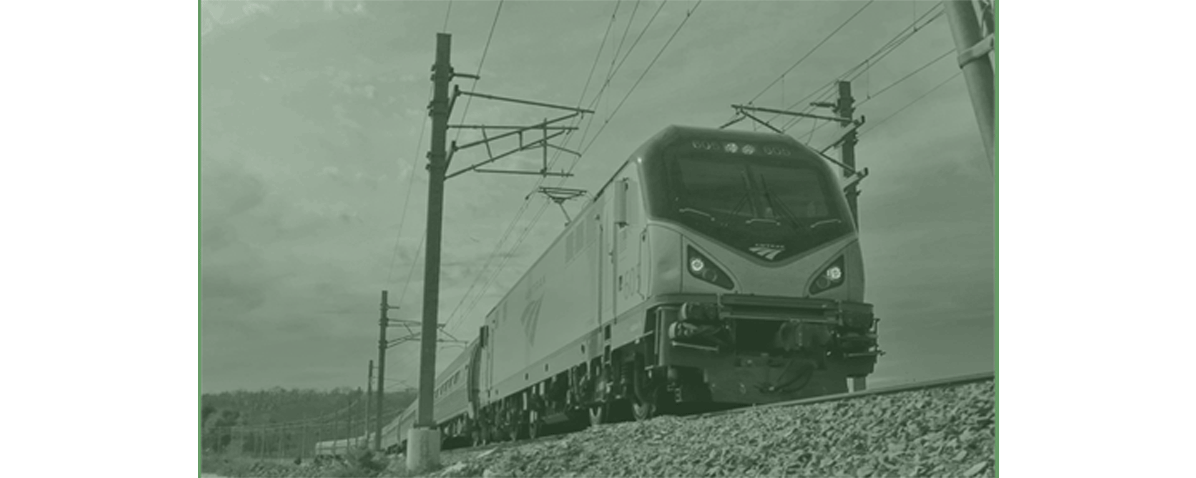
Transport Decarbonisation Plan for the UK
MTA Long Island Rail Road President Phillip Eng announcing on April 19, 2021 that the LIRR had entered into an agreement with Alstom to test batteries that could enable electric railcars to travel on the railroad’s diesel branches. (Photo: Glen Sager / MTA LIRR)
BATTERY TRAINS ON THE LIRR?
UPDATED 2022
In July of 2022, the Long Island newspaper Newsday reported that the LIRR, after completing a feasibility study, would not move forward with the planned next phase of testing prototype battery trains. The cost of $26 million for Alstom to outfit two M7 electric-multiple unit train cars was significantly more than the cost of buying a pair of new train cars. The LIRR's new M9 fleet costs about $3.6 million per car.
The railroad, which spent $860,000 on the eight-month feasibility study, had hoped to take the next step by operating a test of a battery-electric train this year (2022) on its Oyster Bay line - the shortest of the LIRR's nonelectrified branches. LIRR officials said they hope the technology could still be part of the railroad's future. "There's a lot of optimism about this. We want this to work," said Rob Free, the LIRR's senior vice president of operations. "We continue to look to see if it's possible down the road."
The Long Island Rail Road in spring 2021 had entered into a $860,000 agreement with train manufacturer Alstom (which has facilities in Hornell, Plattsburgh, and Rochester) for a feasibility study on operating battery-electric multiple units (BEMUs) throughout its system to replace diesel traction over the non-electrified segments of its system.
“This changes the dynamics for how we look at our capital program needs in the future," LIRR president Phillip Eng stated at the time in an exclusive interview with Newsday. "This is an opportunity to really look at a technology that could address this in a manner that is achievable, fundable, and the cleanest form of service that we can think of.”
The plan was to retrofit the railroad’s existing M7 EMU cars with batteries as opposed to ordering new trainsets. The trains would run off the existing DC third rail in electrified territory and then seamlessly switch to batteries in the current non-electrified diesel territory. Charging stations located at the end of branches would re-energize train batteries between runs, the lithium-ion batteries taking about 10 minutes to charge.
The LIRR had stated that such trainsets would negate the need to further electrify the railroad's tracks, however given the 50-mile (80km) range of Alstom’s existing Coradia Polyvalent BEMU trainsets, this seemed unlikely for the Ronkonkoma and Montauk branches without some extension of third rail electrification, due to both having long unelectrified segments of 46 and 79 miles. However, both the Oyster Bay and Port Jefferson branches did fall within in the range of battery operation.
Image Source: LIRR via Wikipedia
The yearlong study was funded out of the LIRR's operating budget and was to include simulations of battery-powered trains. If determined to be feasible, the next step would have been for a pair of M7 electric cars to be equipped with batteries and then tested on a non-electrified branch, identified as likely the Oyster Bay line, which would be fitted with a battery charging station at its terminal. If successful, the LIRR would then have converted the rest of the M7 vehicle fleet while also incorporating batteries in all new rolling stock orders.
The feasibility study however found several unexpected issues, including potentially having to build additional electrical substations to charge the trains while also powering the third rail. Making space for the battery compartment inside the existing M7 train cars would have required removing nine seats per car, reducing capacity. There were concerns that if a train were unexpectedly delayed, it could run out of power and strand passengers on board. Charging the trains between runs also reduced their availability for service.
Overall if the project had not been canceled, this could have been the first step being taken by a railroad in New York State to fulfil the goals of the Climate and Community Investment Act of moving to a zero-emission transport system. At the time NJ Transit was also following the LIRR in looking at batteries to eliminate diesel traction on lines that are partially electrified today. As of 2022 the Massachusetts Bay Transportation Authority (MBTA) was examining “discontinuous electrification” – a concept that could electrify the MBTA regional rail system faster, with lower infrastructure costs, by relying on battery-equipped electric trains. Using batteries aboard trains could help the MBTA avoid costly construction of overhead wires in places where they may be difficult to install and maintain, such as near bridges and tunnels.
For long distance services covering over a hundred miles batteries are not a solution due to their lower weight-to-power ratio than diesel or hydrogen fuel cell motive power, however for distances of measure in tens of miles, batteries can lead to all electric motive power while limiting the need to extend either third rail or overhead electrification. Still, some rail advocates – including Alon Levy and Transit Matters – point out that unlike in-motion charging for battery buses that discontinuous electrification with gaps in overhead catenary or lineside third-rail is not much of a cost savings compare to full electrification due to the construction cost of substations and much higher costs of a bi-mode BEMU compared to standard EMUs.
Transit Matters in a report on the proposed electrification of the Boston commuter rail system explained that the BEMUs being ordered in Europe are for lightly used passenger lines with "hourly three-car trains" where the extra cost of acquiring and operating a few battery trains is outweighed in the cost-benefits analysis by the larger cost of electrifying the tracks. For busy regional rail systems, replacing diesel fully with electric multiple-units utilizing overhead catenary was the most cost-effective strategy for going net-zero while significantly improving rail service.
The LIRR must ultimately meet the net-zero mandate of the state’s Climate Act and eliminate diesel traction. A letter from a coalition of Long Island business and conservation groups to state climate leaders in July 2022 urged them to require the LIRR to eliminate its diesels, and electrify its entire system, as part of the state's goal to become carbon neutral by 2050.
"While the news regarding battery trains is disappointing, the NYS Climate Act deadlines are not budging," said Kyle Strober, executive director of the Association for a Better Long Island (an economic development group) and one of the letter's authors was quoted in Newsday. "The need for electrification to meet the state's green mandates appears even more urgent."
The MTA in its forthcoming "Twenty Year Needs Assessment" infrastructure investment report is considering expanding electrification, while warning that electrification could be cost prohibitive and require the taking of private property. The MTA will have sooner than later take big steps in transitioning its remaining diesel operations to carbon-neutral motive power, be it third rail, catenary, batteries, or hydrogen fuel cells.





